
An atmospheric river will bring heavy rainfall to lower elevations of California this week, and heavy snow to the Sierra Nevada mountains. Flash flooding, some of which may be locally considerable, will be a concern on the western foothills of the Sierra Nevada mountains through Tuesday. Landslides, rockfalls and mudslides are possible in the Southern California mountains. Read More >
Overview
|
All images on this page may be expanded with a single click and returned to original size with a second click. Starting all the way back on February 1st, an upper-level low began to take shape over Alaska. Over the course of the next week, the system would intensify and traverse thousands of miles to arrive on the doorstep of the Florida peninsula. By February 6th, a potent setup had taken shape, with a strong cold front extending into the Gulf of America. Across Florida, temperatures were warm and humid. Breezy southerly flow had transported large amounts of moist, tropical air northward, allowing temperatures to climb into the mid-80s. Behind the front, conditions were cold and dry as northern arctic air funneled south. This distinct difference, a common occurrence in winter, had an extra boost as the jet stream dipped farther to the south, producing strong, gusty winds near the surface. What was already a favorable environment for storms had become even better. All across the peninsula, many would report strong winds and minor damage. However, what is most likely to be the most memorable element of the event was the EF-0 tornado that impacted parts of Pinellas County; uprooting trees, damaging homes, and even toppling a crane onto I-275. |
||
|
Infrared Satellite
|
Radar Loop 02/06/2020 - 02/07/2020
|
|
Tornado:
|
Tornado - Seminole → Pinellas Park
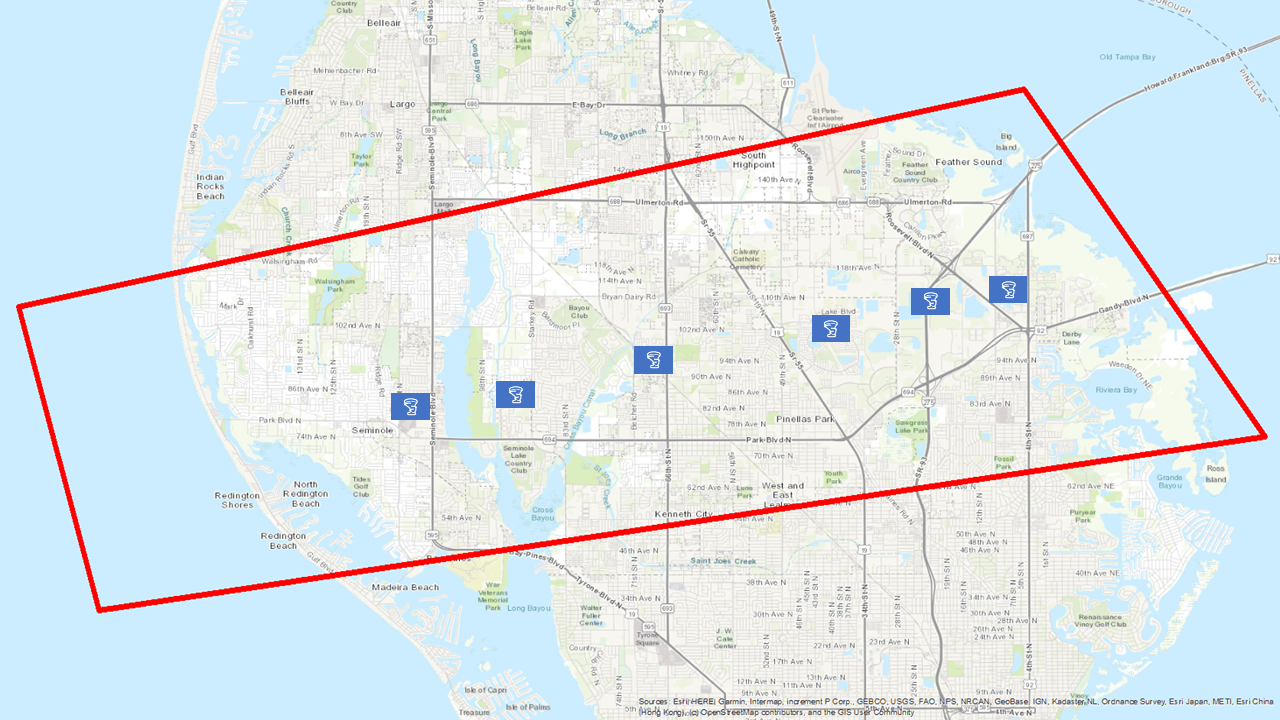 |
||||||||||||||||||||||
The Enhanced Fujita (EF) Scale classifies tornadoes into the following categories:
| EF0 Weak 65-85 mph |
EF1 Moderate 86-110 mph |
EF2 Significant 111-135 mph |
EF3 Severe 136-165 mph |
EF4 Extreme 166-200 mph |
EF5 Catastrophic 200+ mph |
 |
|||||
Photos
Pinellas County EF-0 Tornado:
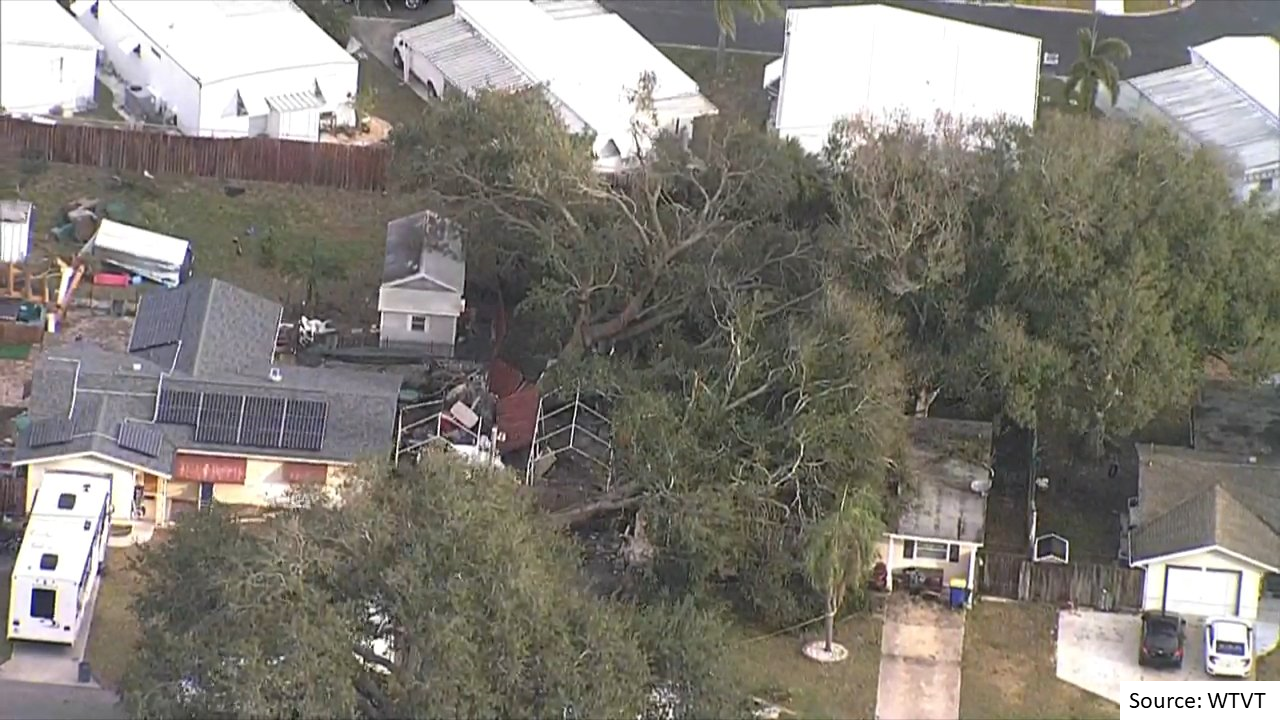 |
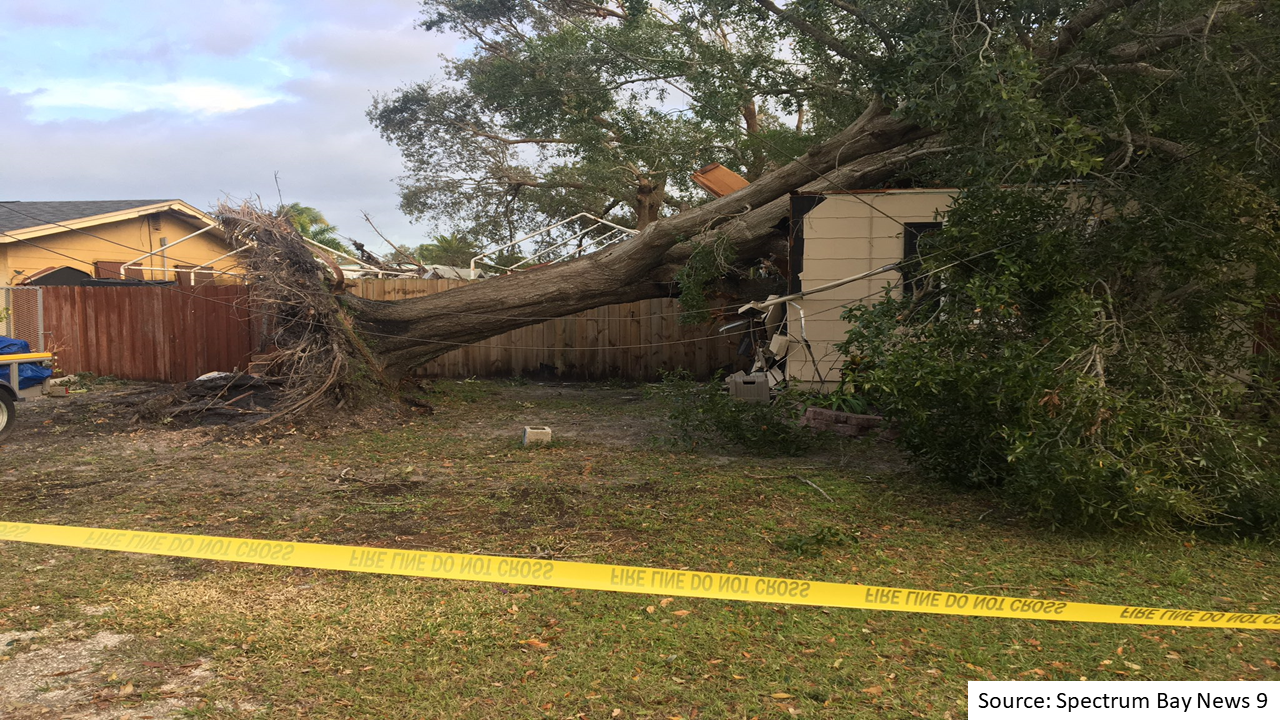 |
| Photo Credit: WTVT | Photo Credit: Spectrum Bay News 9 |
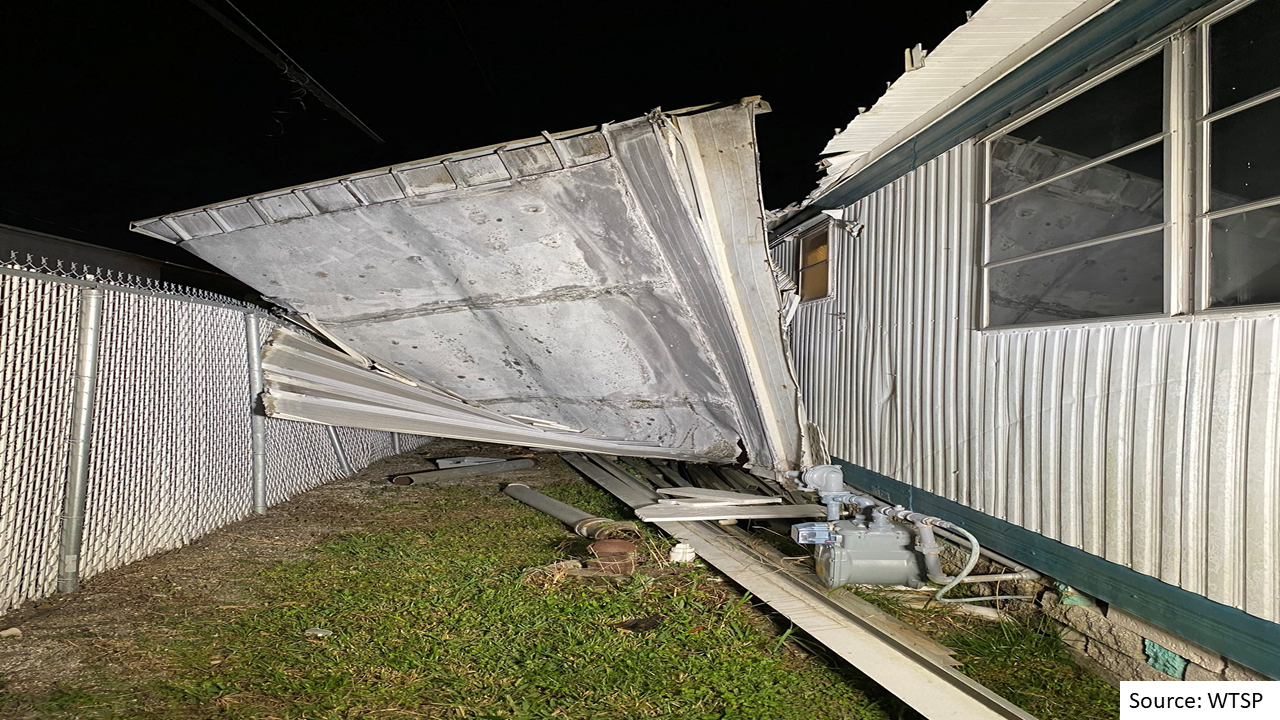 |
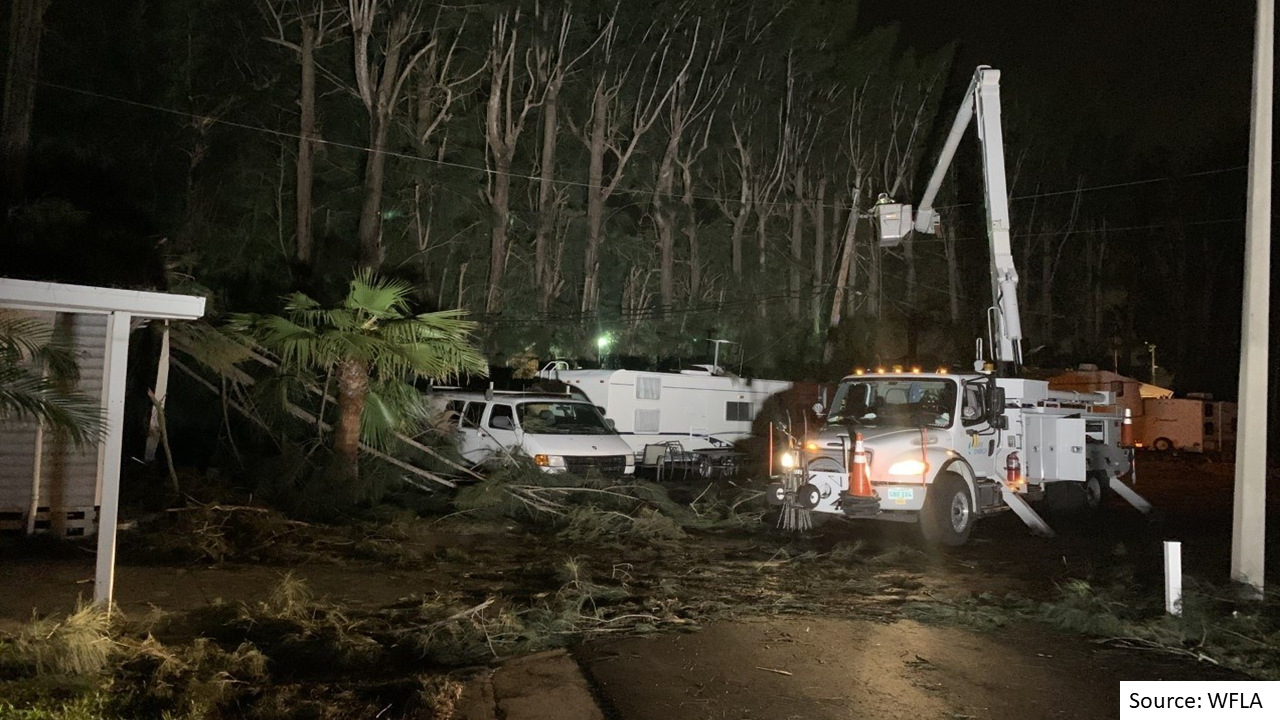 |
| Photo Credit: WTSP | Photo Credit: WFLA |
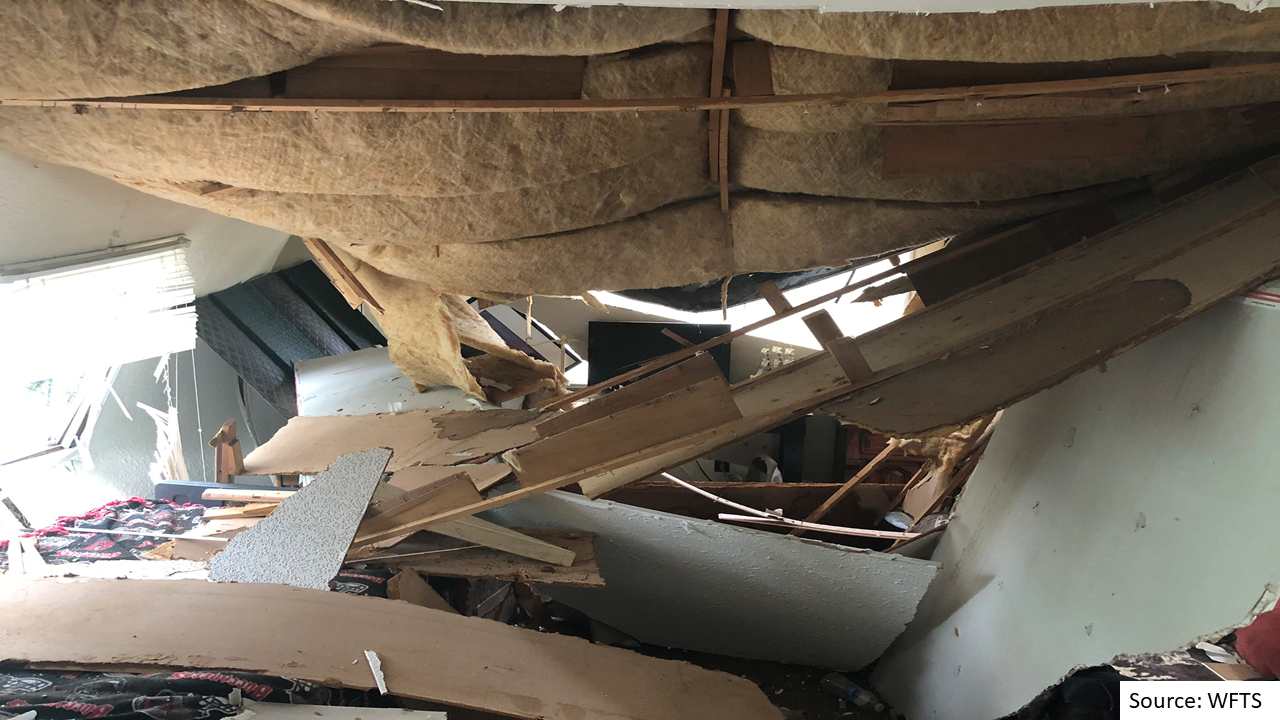 |
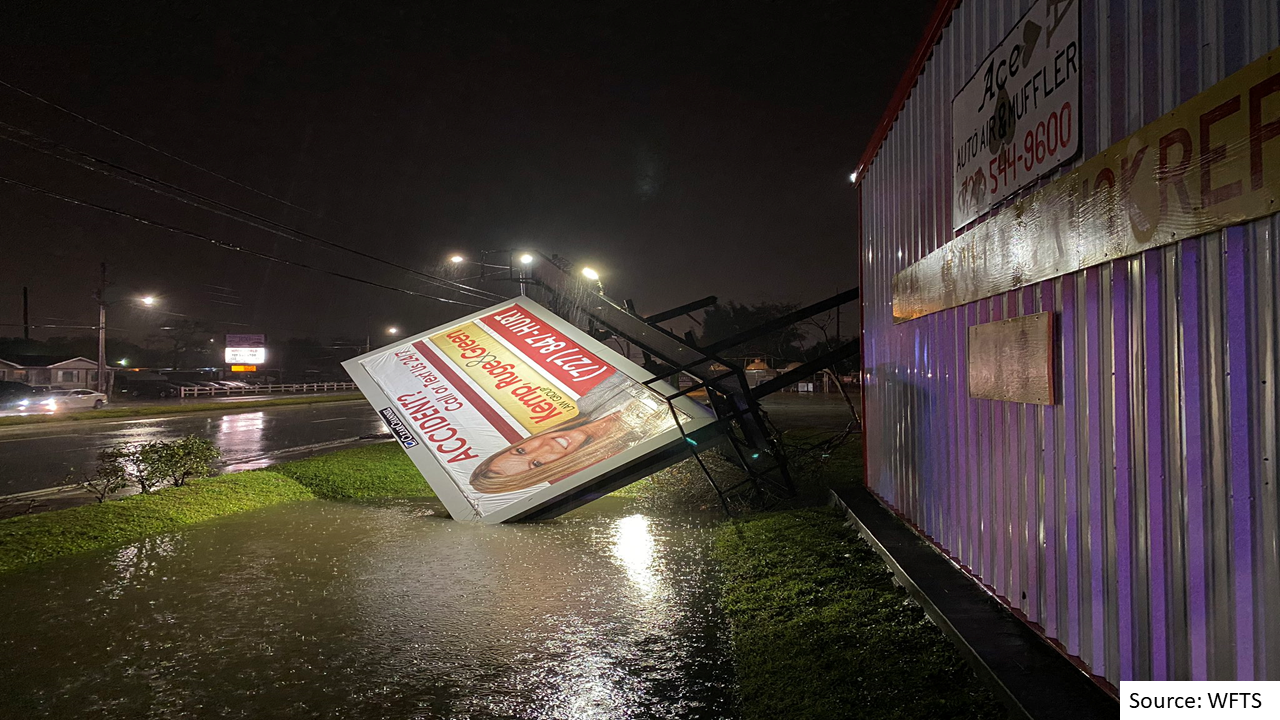 |
| Photo Credit: WFTS | Photo Credit: WFTS |
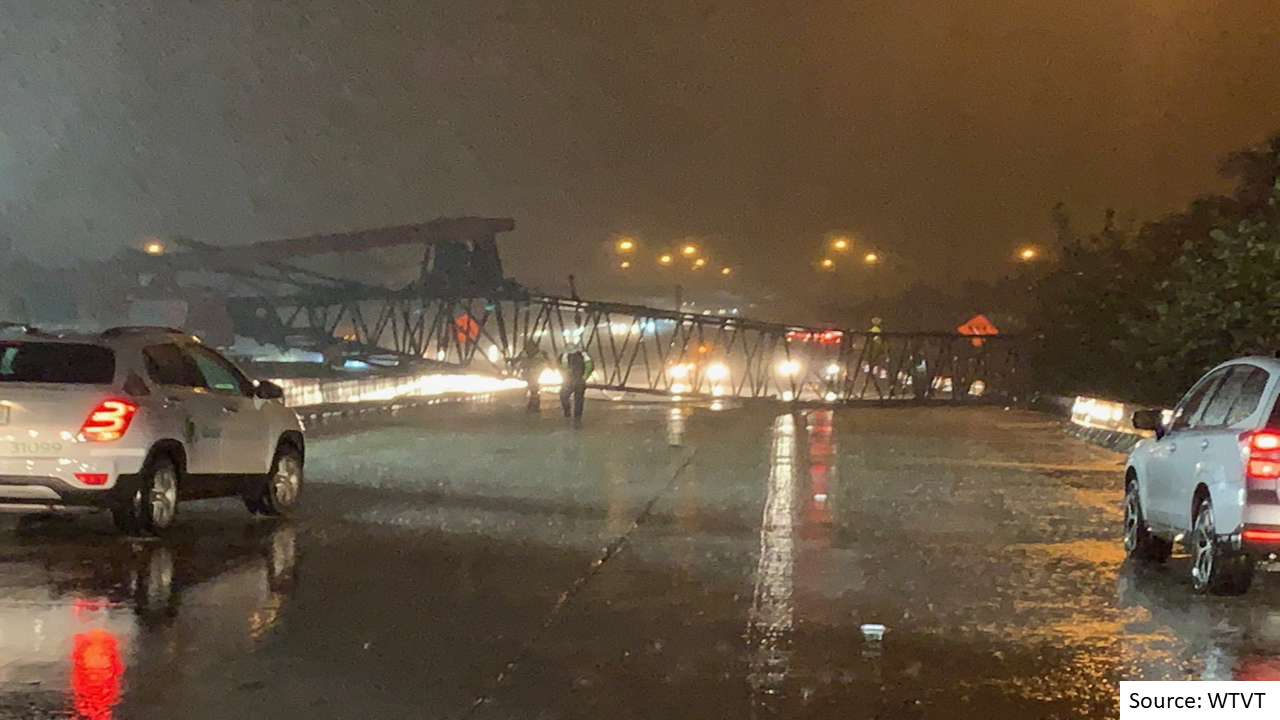 |
|
| Photo Credit: WTVT |
Other Wind Damage:
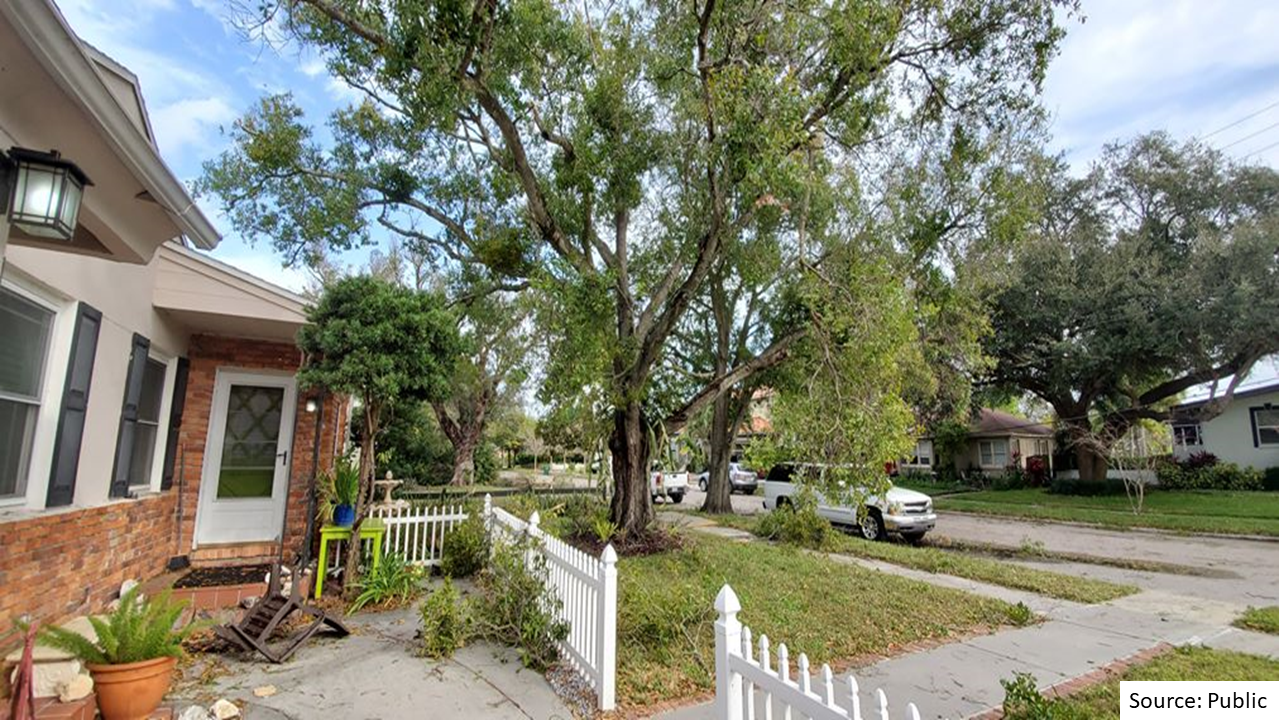 |
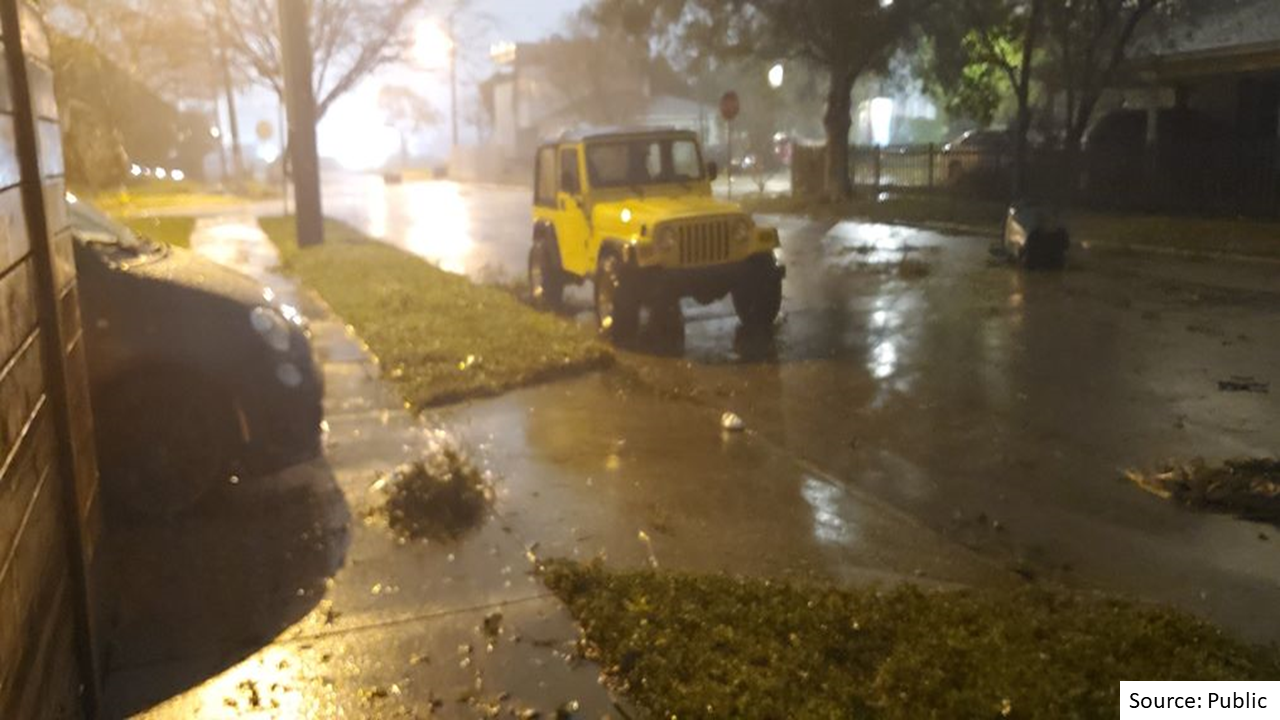 |
| Photo Credit: Public | Photo Credit: Public |
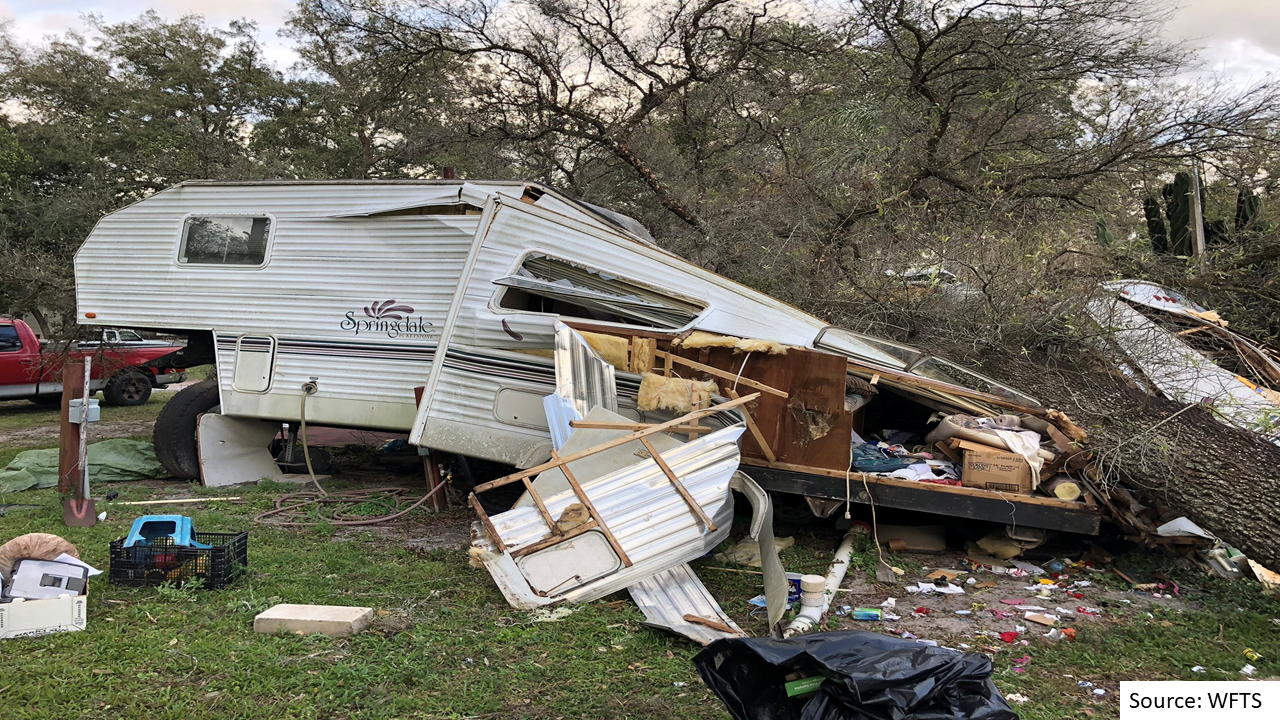 |
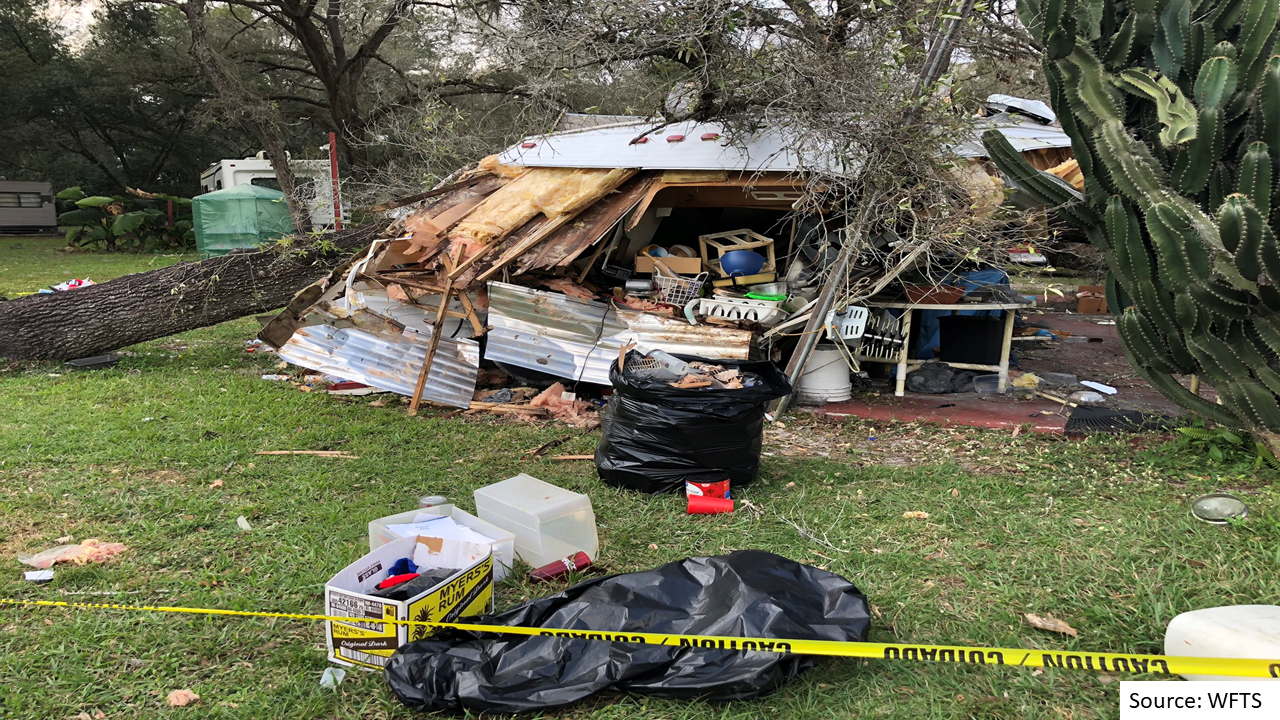 |
| Photo Credit: WFTS | Photo Credit: WFTS |
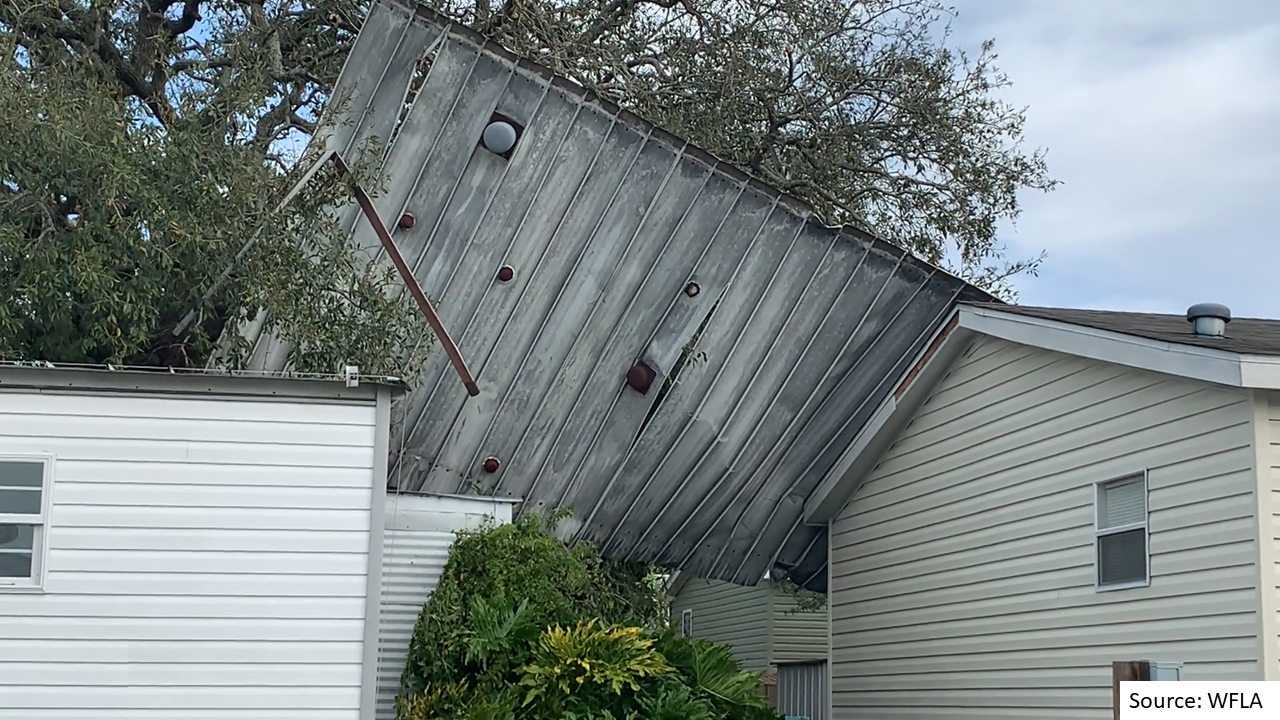 |
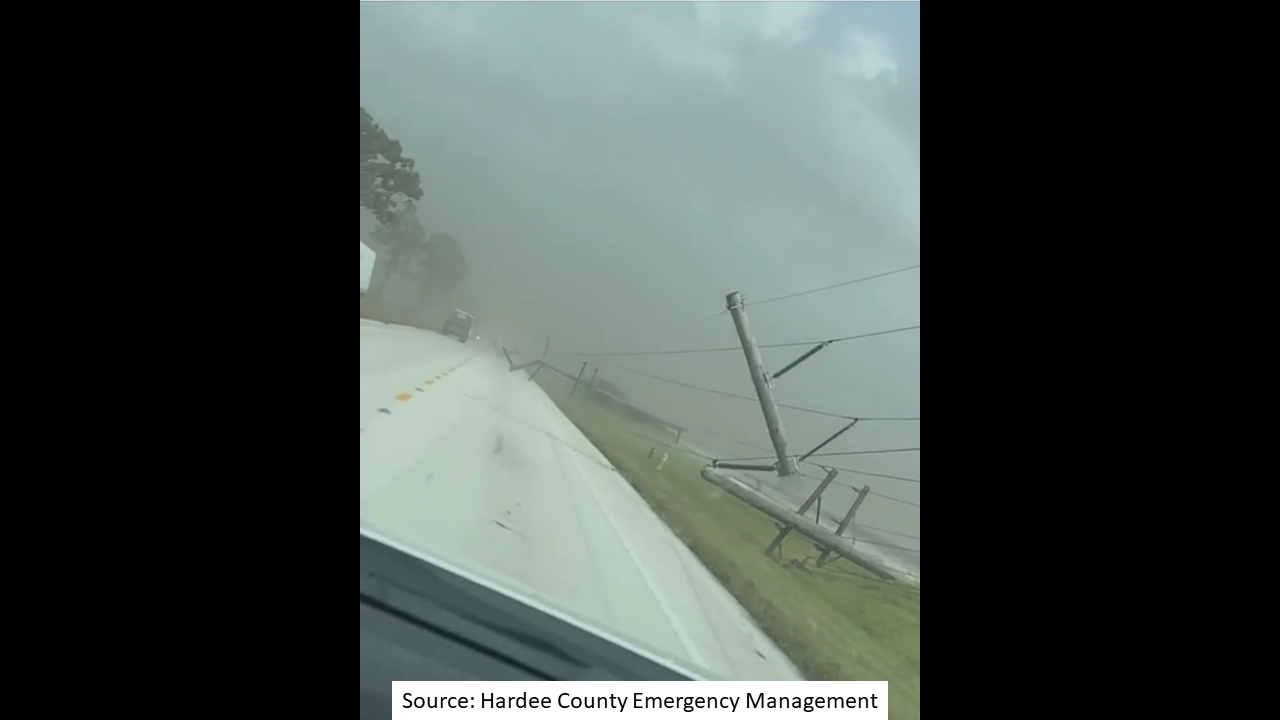 |
| Photo Credit: WFLA | Photo Credit: Hardee County EM |
Radar
Radar Snapshots:
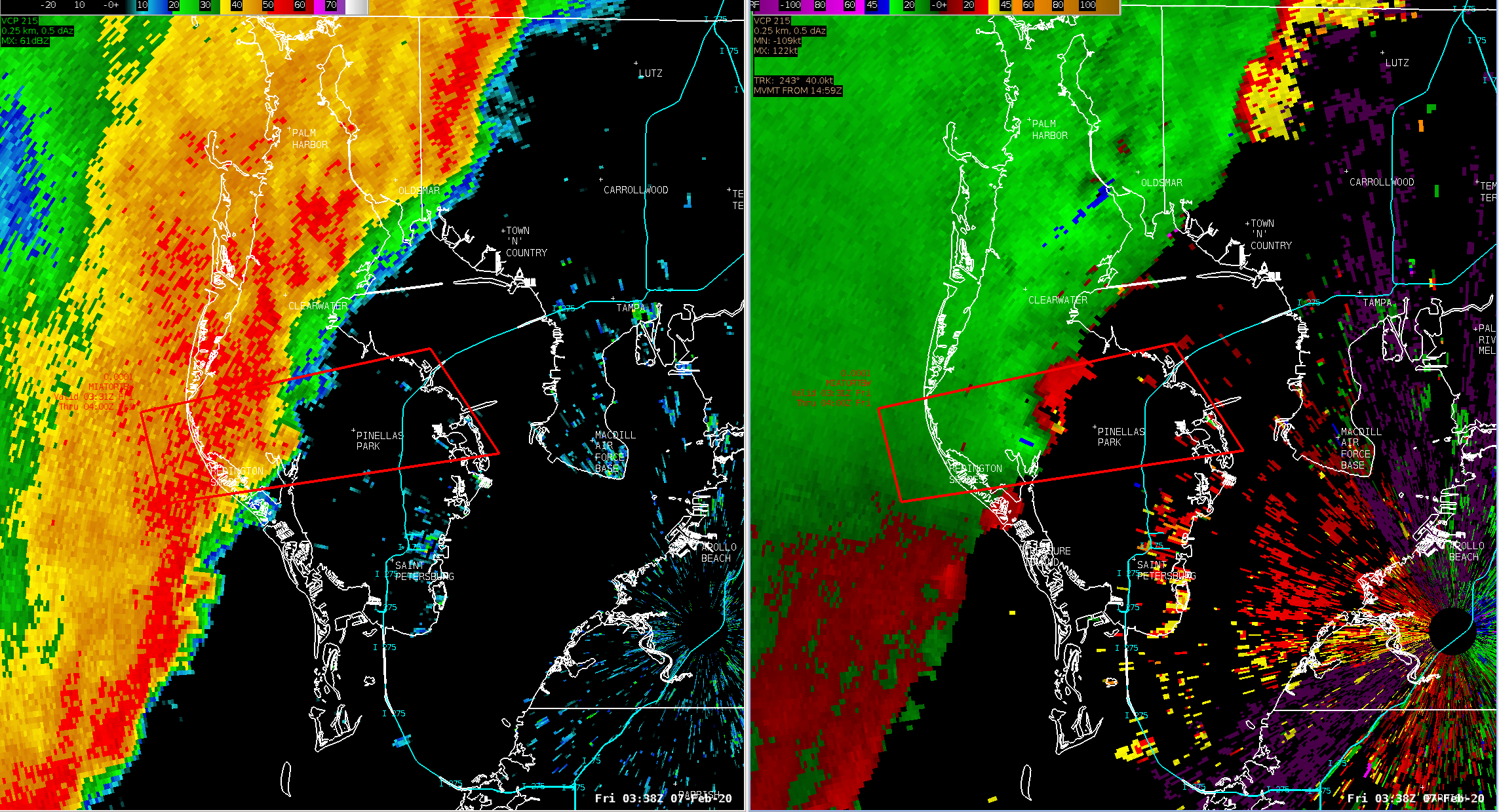 |
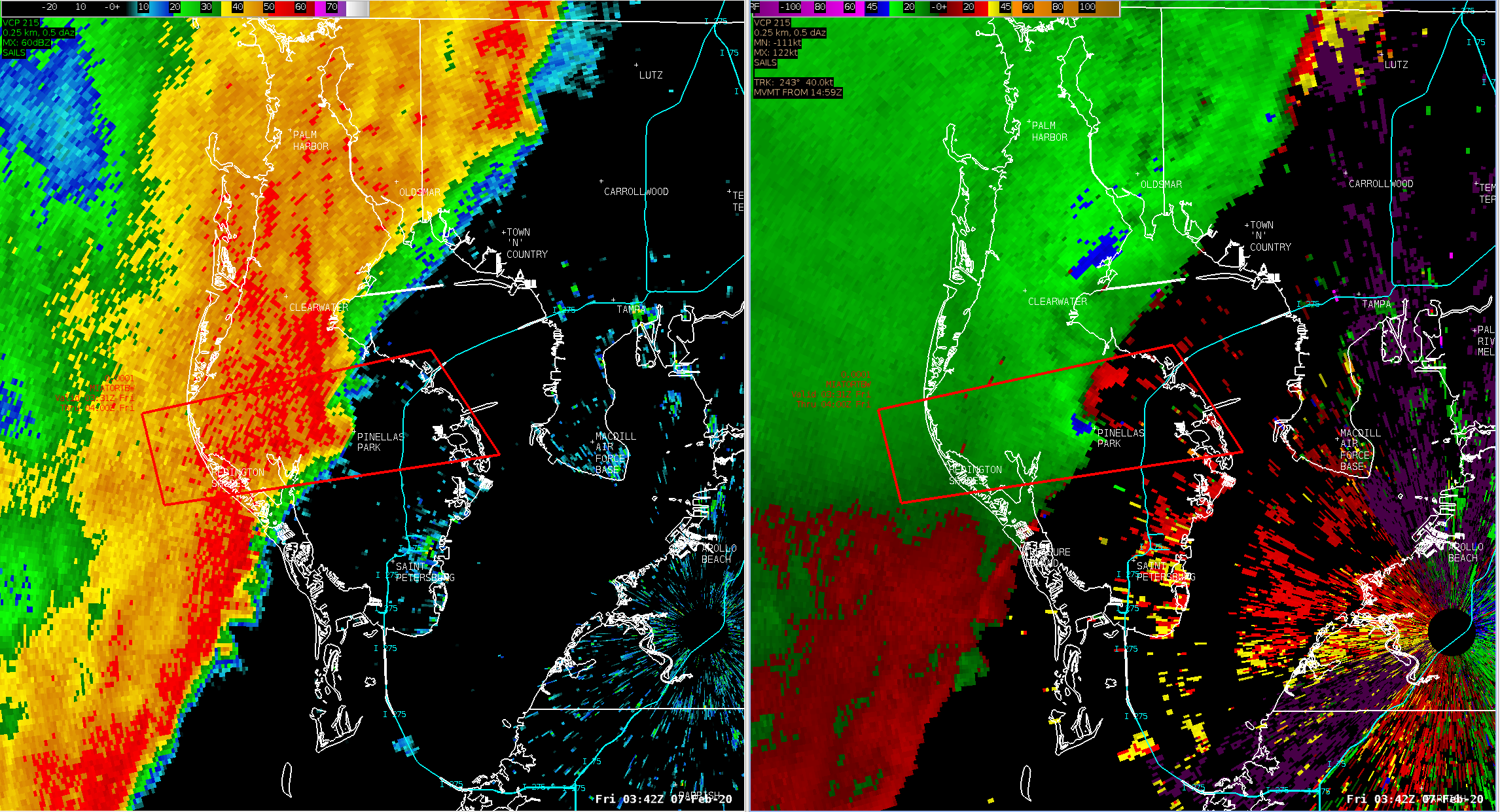 |
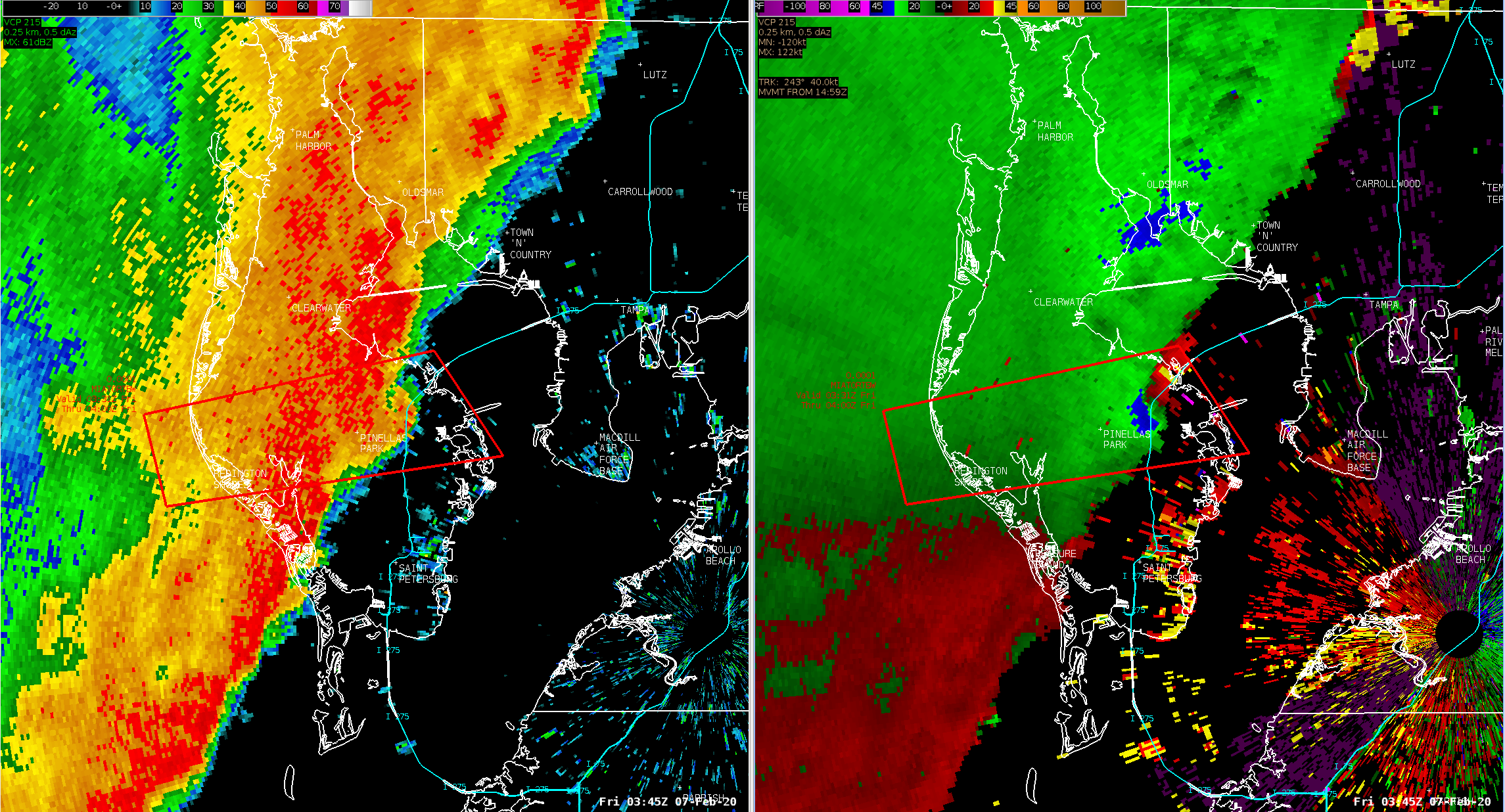 |
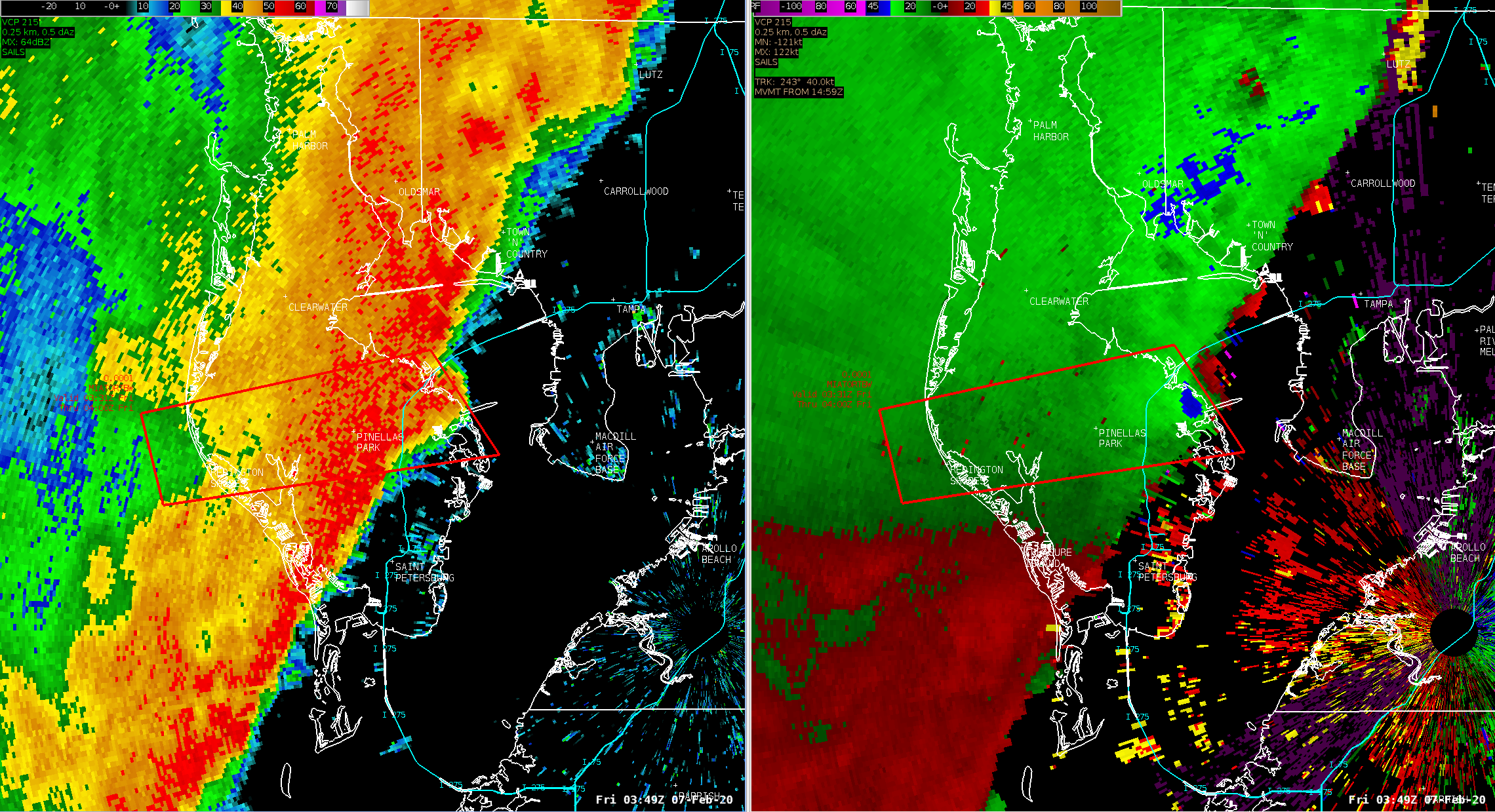 |
|
Pinellas County - February 6, 2020 |
|||
Rainfall:
The entire region saw some rain as the squall line moved through, but the duration of the heavy rainfall was less than 1 hour so rainfall amounts were generally between 0.50 and 1 inch.
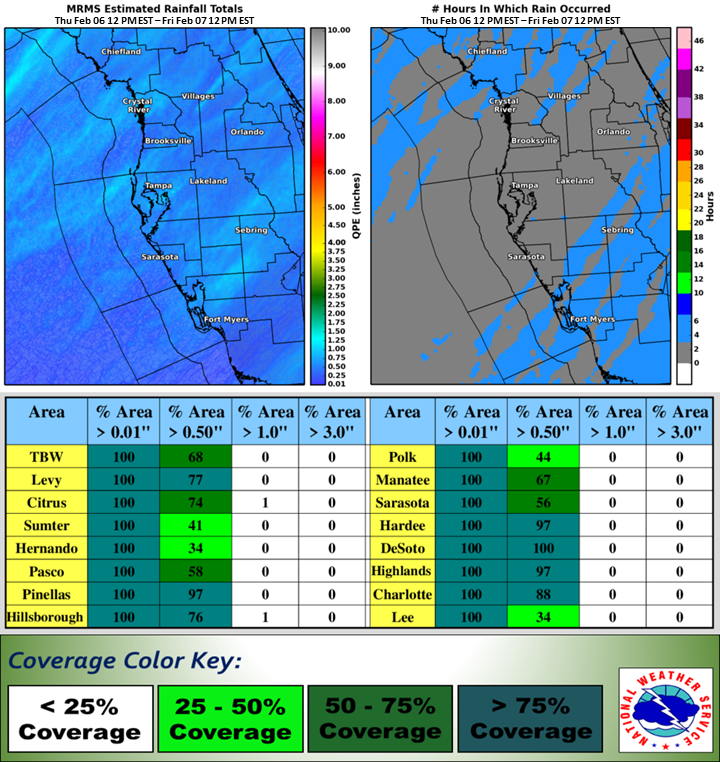 |
| MRMS (Multi-Sensor-Multi-Radar) rainfall estimation statistics across the region for the event. |
Environment
A well defined cold front was approaching the region at 03 UTC/10 PM EST on February 6th as seen in Figure 1 below. Figure 1 shows strong frontogenesis ongoing in the 1000-850mb layer at 10 PM EST. The frontogenetic forcing served as focused low level lift within the thermal circulation on the warm side of the boundary. Surface based convection in the from of a quasi-linear convective system (QLCS) squall-line was rapidly approaching the coast at this time. Figure 2 (center) indicates a substantial tongue of boundary layer CAPE over the coastal waters, with less, but still positive values along the coastal landmass. Figure 3 (right) shows very strong deep (0-6km) layer environmental bulk shear in place across the region, in excess of 60 knots coincident with the leading edge of the squall-line. This strong shear profile no doubt was aiding both the organization and depth of the convective updrafts.
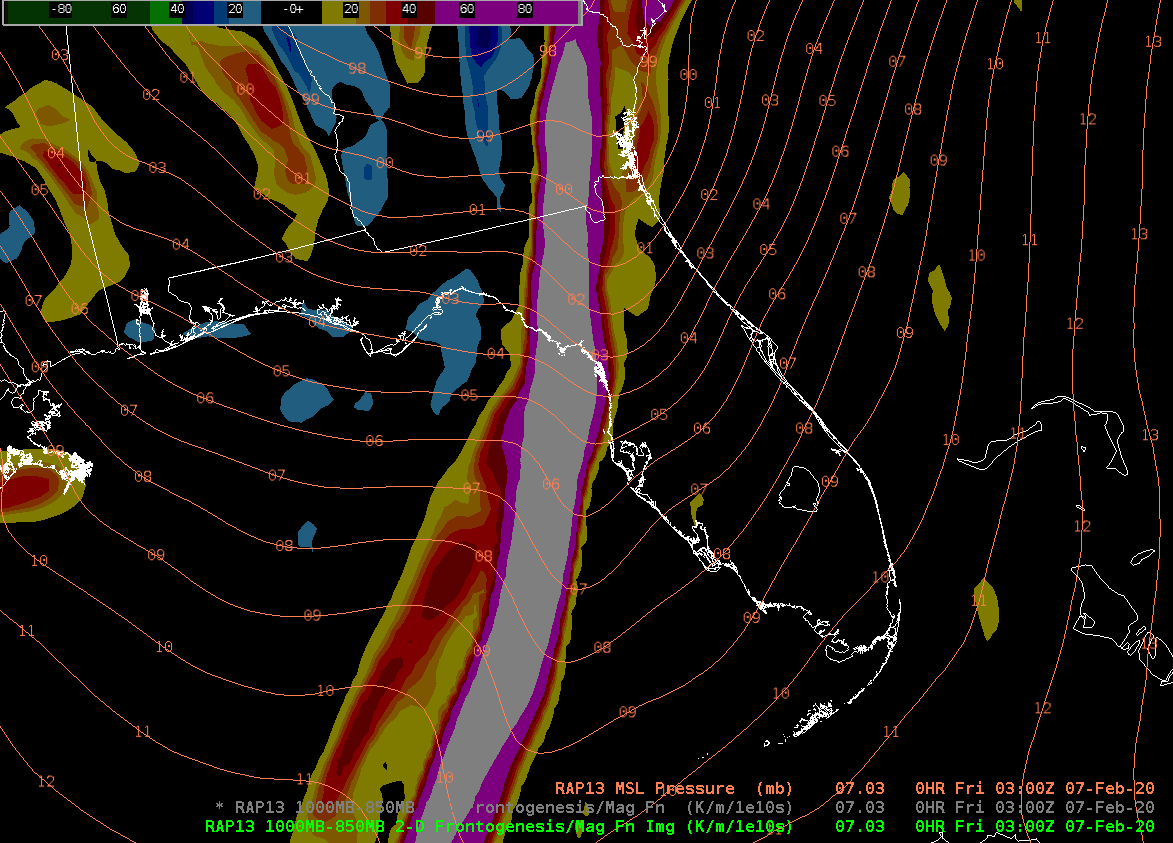 |
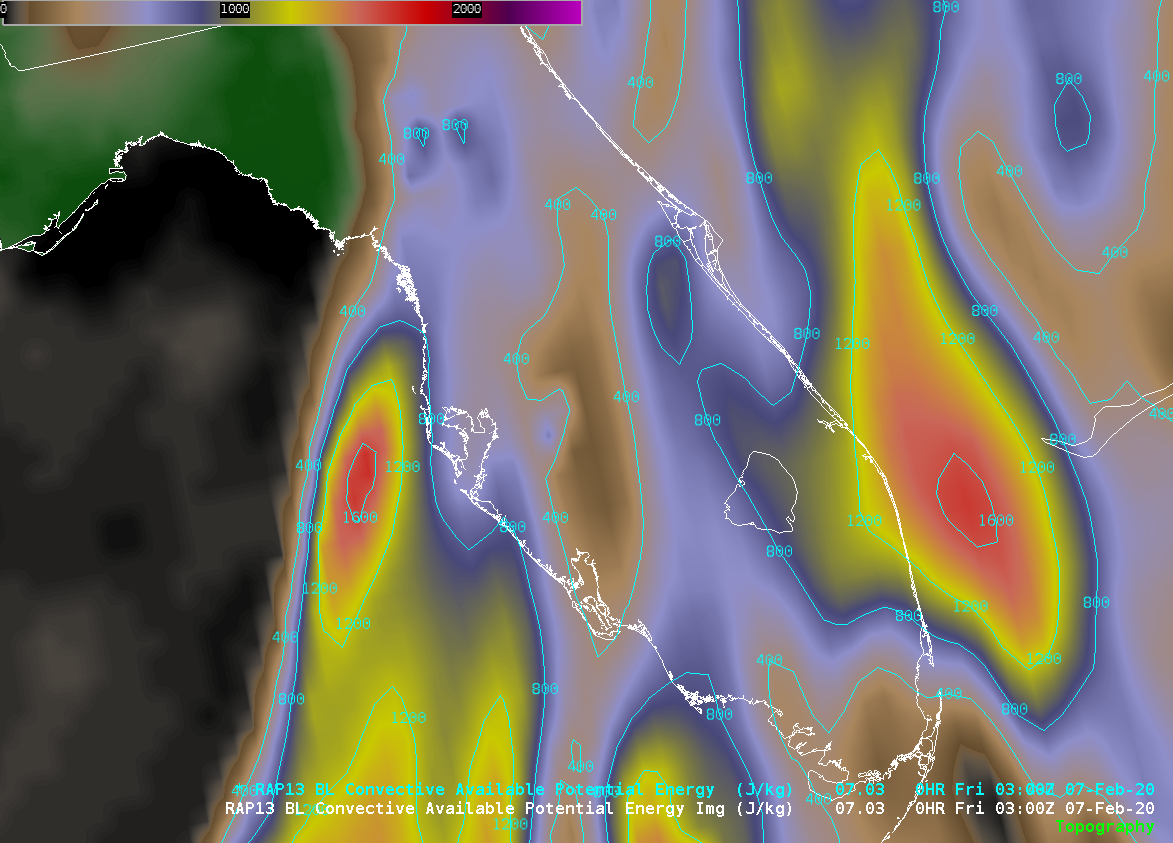 |
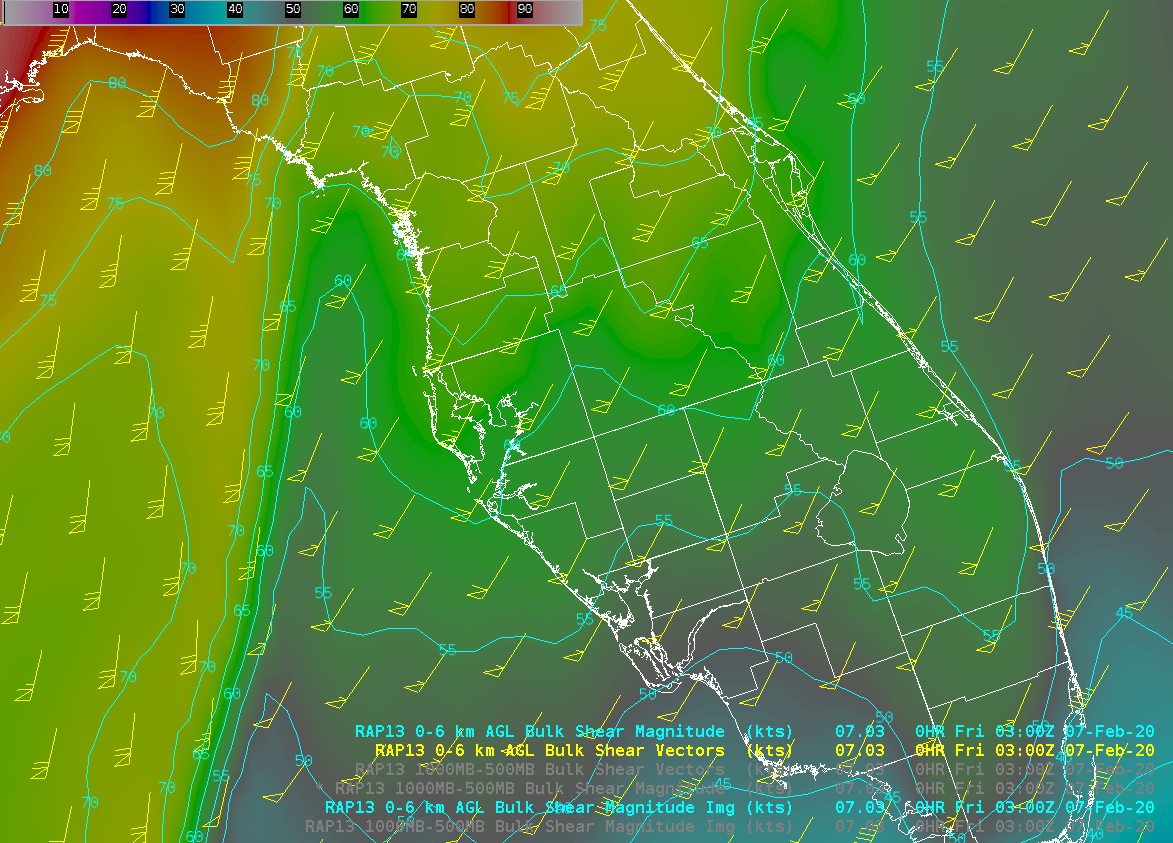 |
| Fig 1) Feb 6th, 2020 - 10 PM EST | Fig 2) Feb 6th, 2020 - 10 PM EST | Fig 3) Feb 6th, 2020 - 10 PM EST |
Impressive 0-3km helicity values in excess of 400 from Tampa Bay northward (Fig 4), and 0-1km helicity values in the 300-400 range (Fig 5) suggested a favorable environment of supercell-like structures to form embedded within the line structure. One segment of the line ingesting this environment began to exhibit some supercell characteristics shortly after 10 PM EST, to the southwest of the Pinellas County coast. This particularly robust convective cell further interacted with the deep layer shear, with upgrowth convective evolution along the direction of the deep layer shear vector. This evolution brought this segment of the line more orthogonal to the 0-3km shear vector, favoring a shear dominated cold pool, and greater potential for meso-vortex development. When a meso-vortex did begin to develop, the lower level processes where almost certainly complimented/coupled by deeper layer updraft processes owing to the 0-6km bulk shear vector. Some signs of this can be extrapolated from the 3D 50dBZ radar rendering in Fig 6 below. The cell/line segment with the developing meso-vortex is exhibiting morphology suggestive of an enhanced/deeper updraft, compared to flanking cells, where the 50dBZ echo is elevated by the strong updraft. This deeper, more robust updraft was what likely led to the surface tornadogenesis over inland Pinellas County during the next 5-10 minutes.
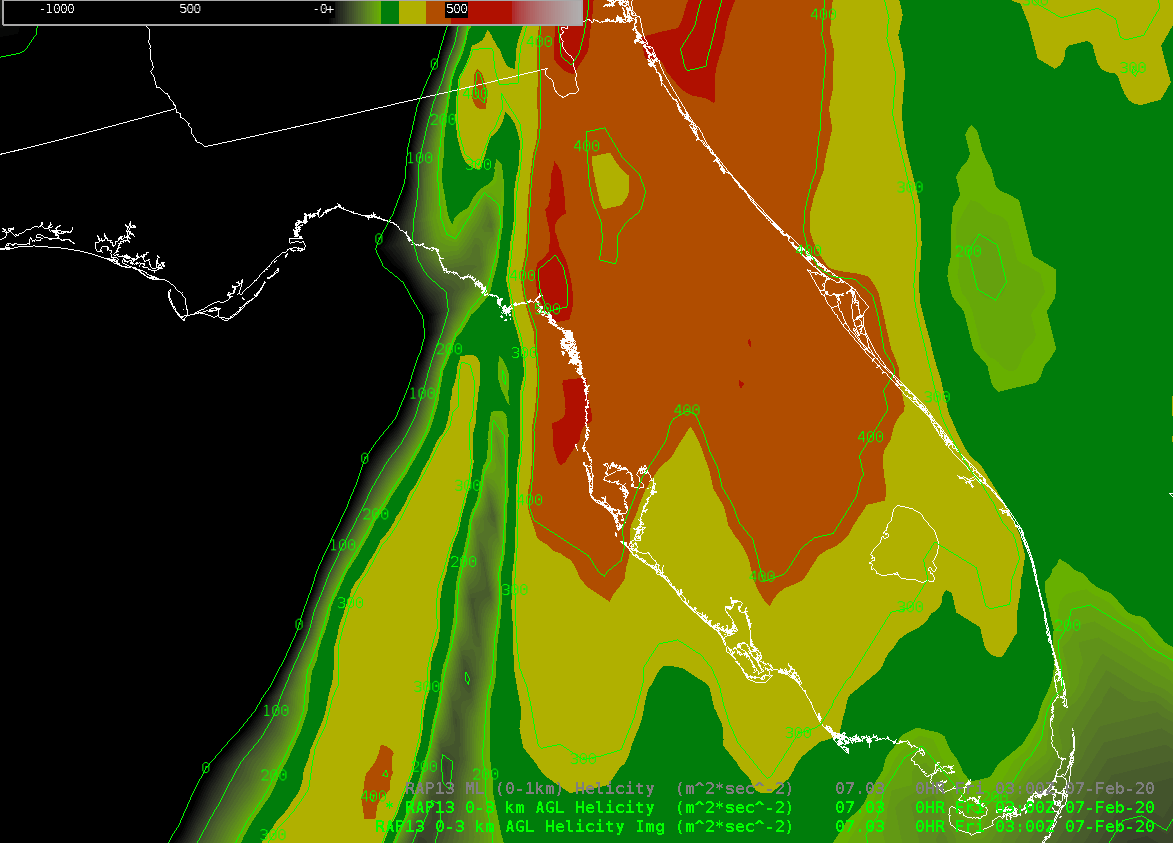 |
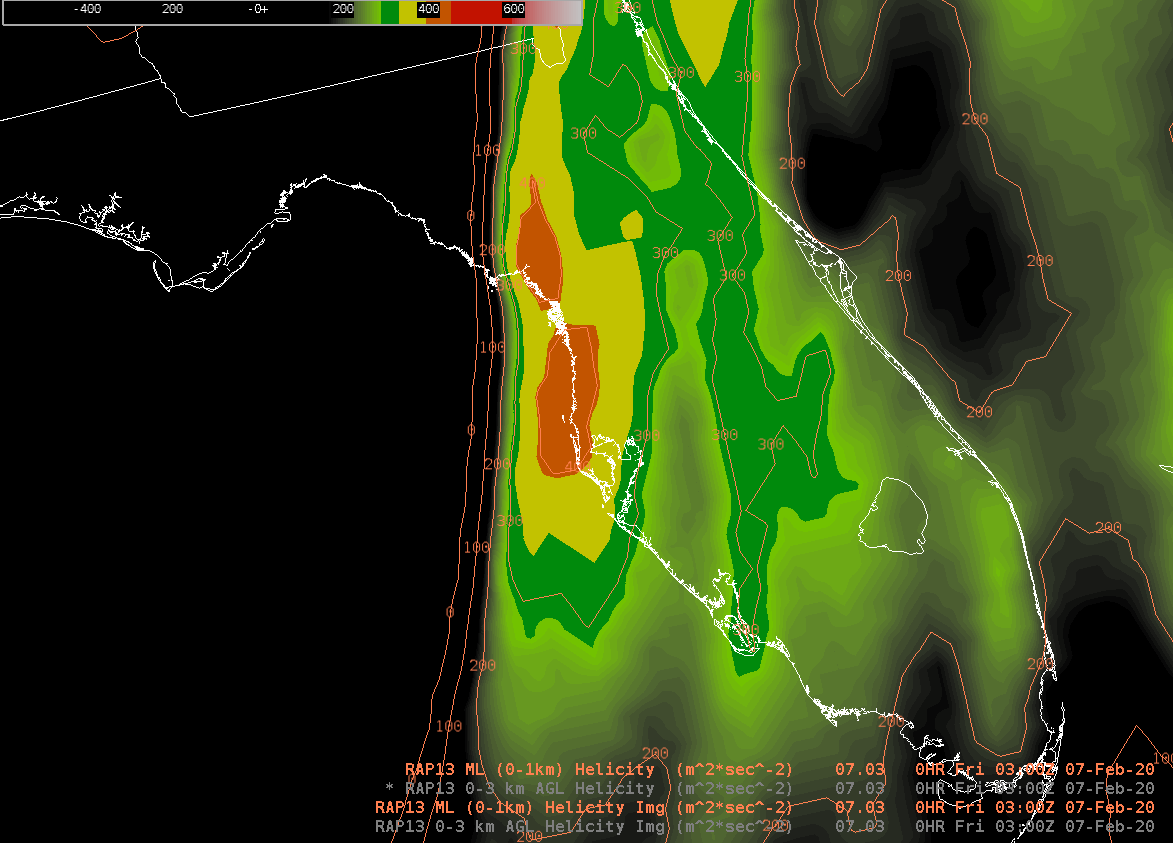 |
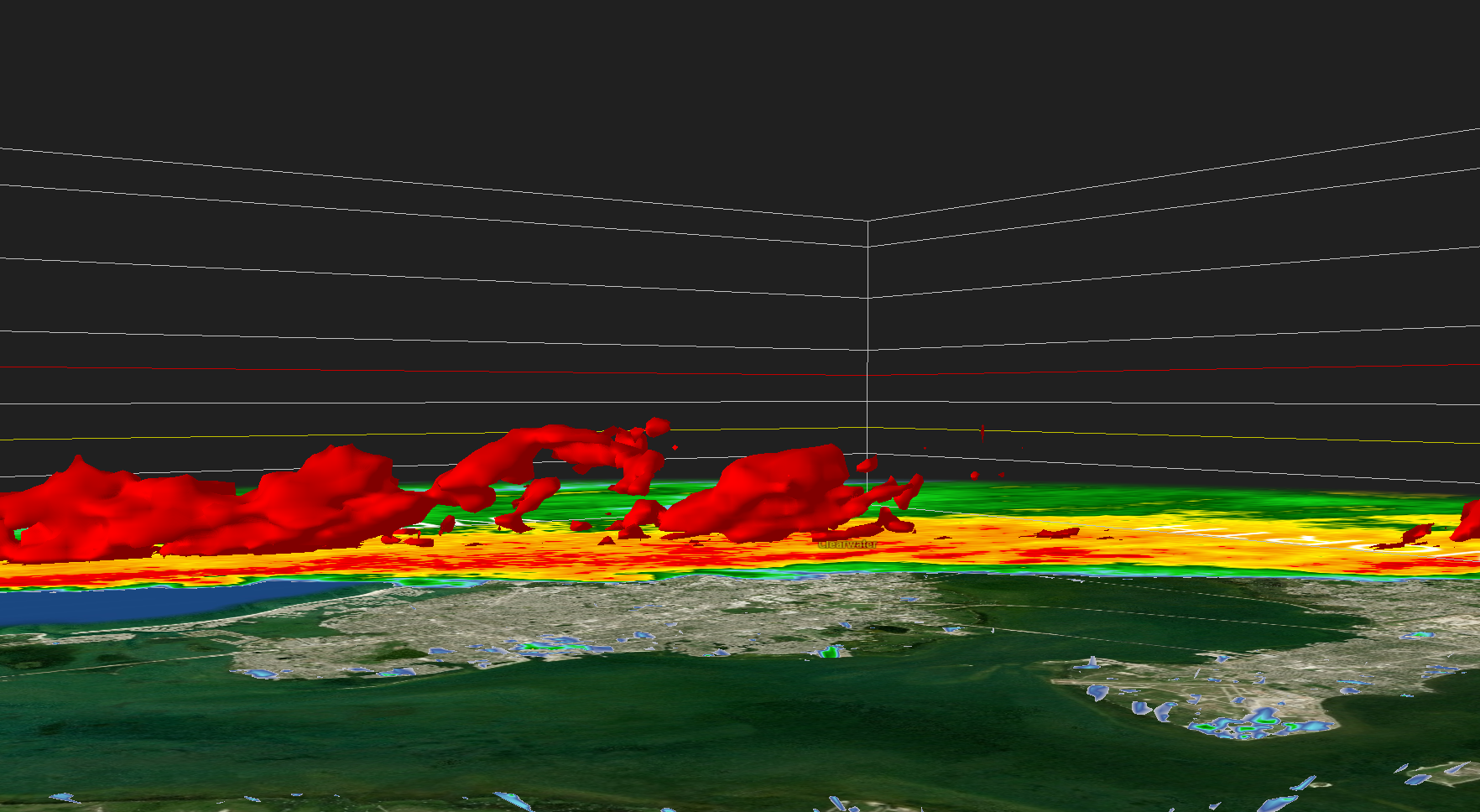 |
| Fig 4) Feb 6th, 2020 - 10 PM EST | Fig 5) Feb 6th, 2020 - 10 PM EST | Fig 6) Feb 6th, 2020 - 10:30 PM EST |
Coastal Flooding
Tide Charts:
The squall-line resulted in minor coastal flooding issues along the northeast Gulf of America. The highest tide cycle associated with the storm ranged from generally 1-3 feet above normal from Apalachicola around the Florida Big Bend and down to portions of Pinellas County. The higher than normal tides from Cedar Key southward resulted in brief periods of tidal over-wash, a few closed roads, and minor beach erosion.
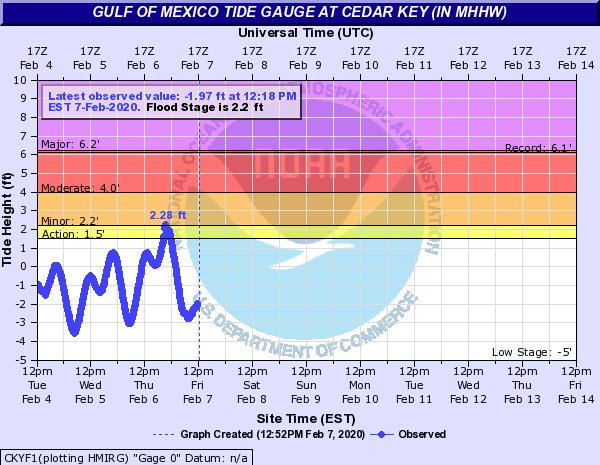 |
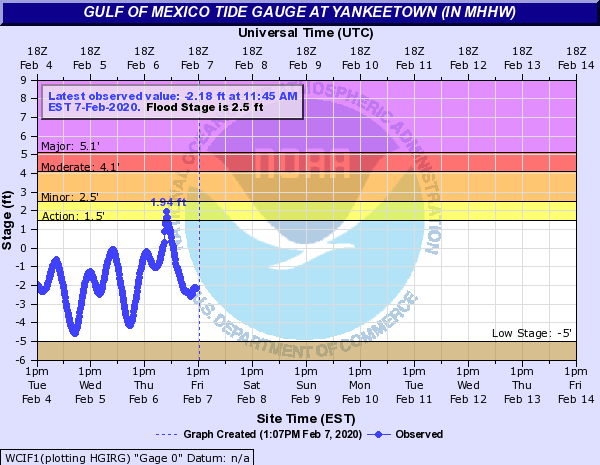 |
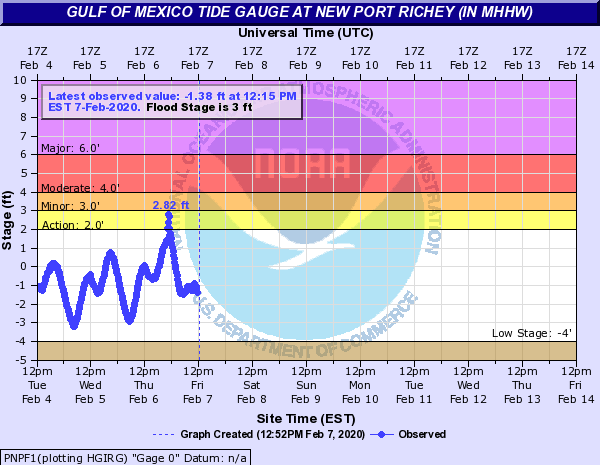 |
| Cedar Key, FL | Yankeetown, FL | New Port Richey, FL |
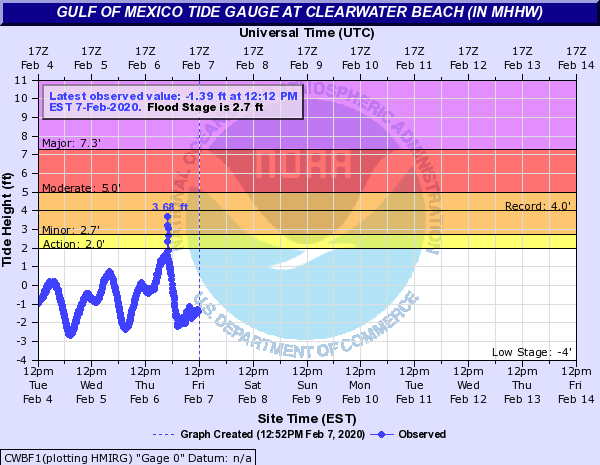 |
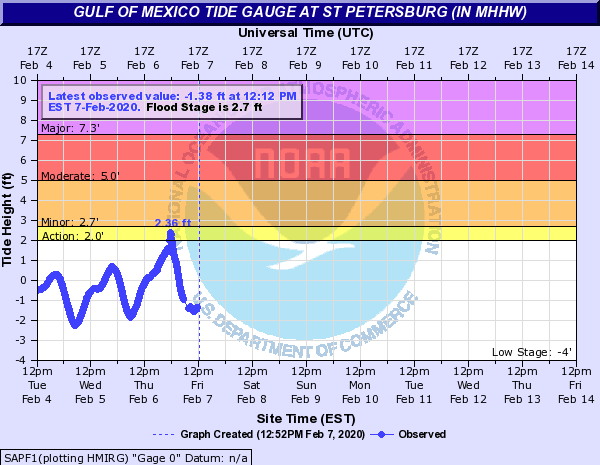 |
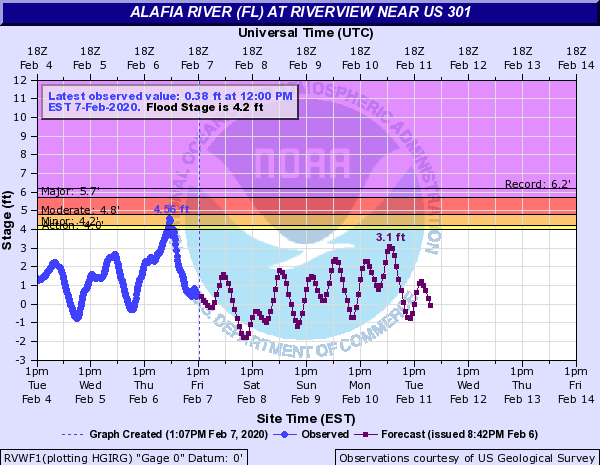 |
| Clearwater Beach, FL | St Petersburg, FL | Riverview, FL |
Meteotsunami Plots:
The highest departures from the predicted tides occurred as the squall line was moving onshore creating what is referred to as a "Meteotsunami" which is a small, weather-driven tsunami caused by changes in air pressure created by fast-moving severe thunderstorms, tropical storms, squalls or other storm fronts.
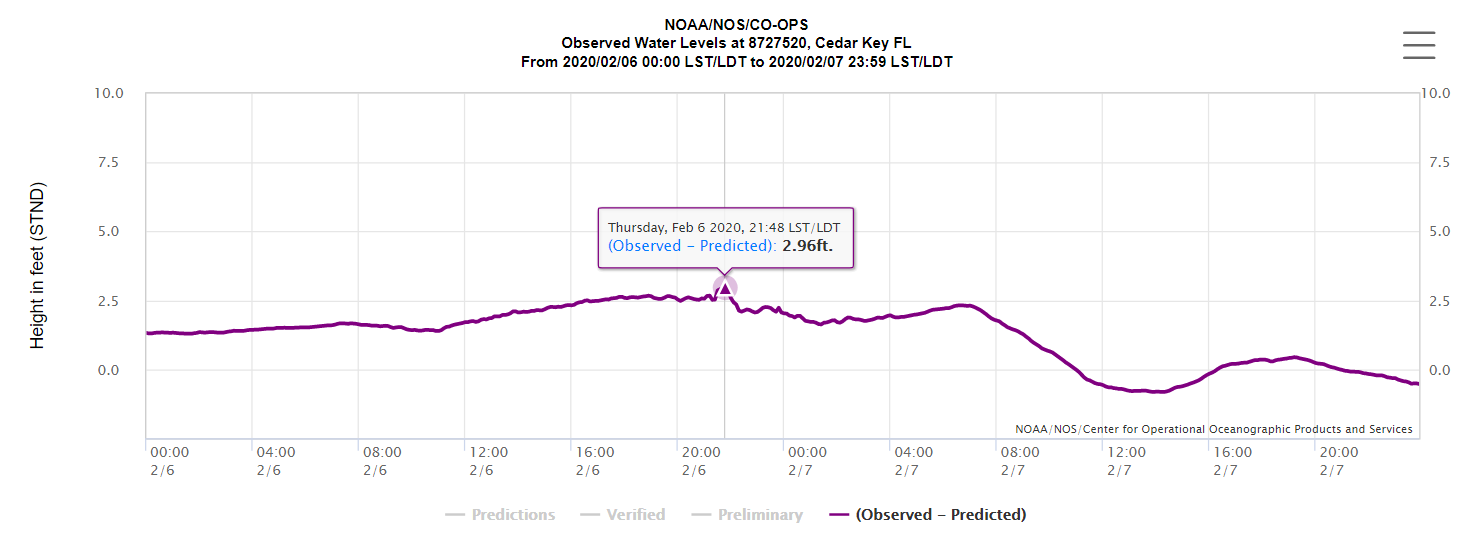 |
| Cedar Key, FL |
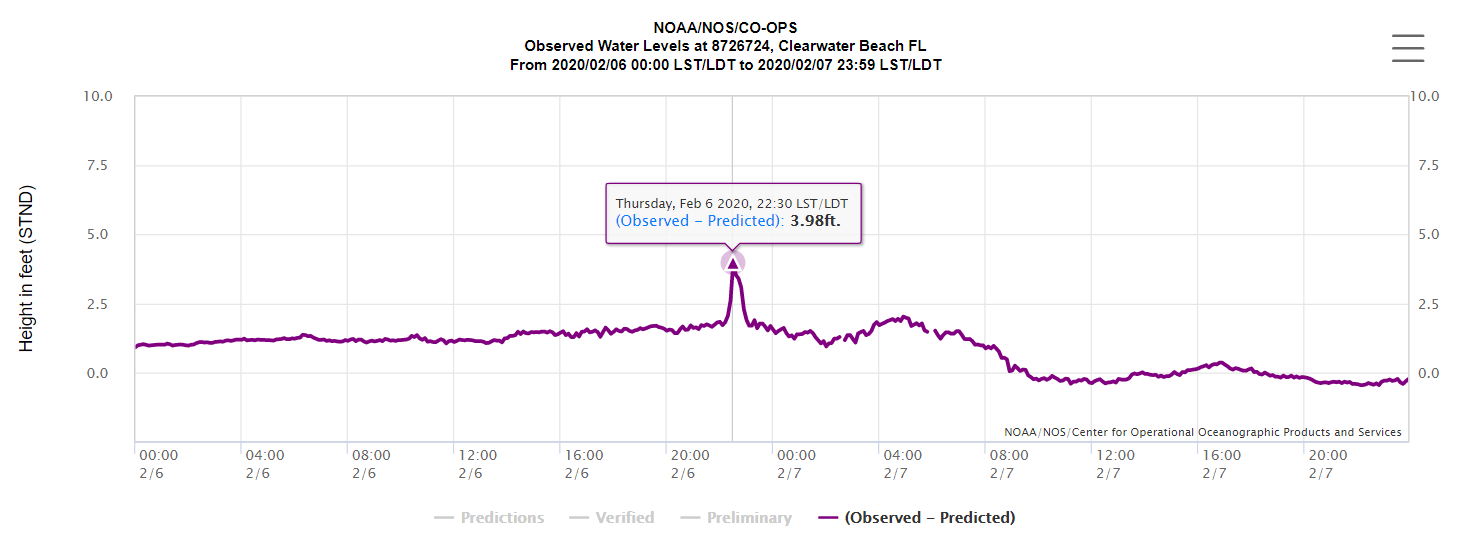 |
| Clearwater Beach, FL |
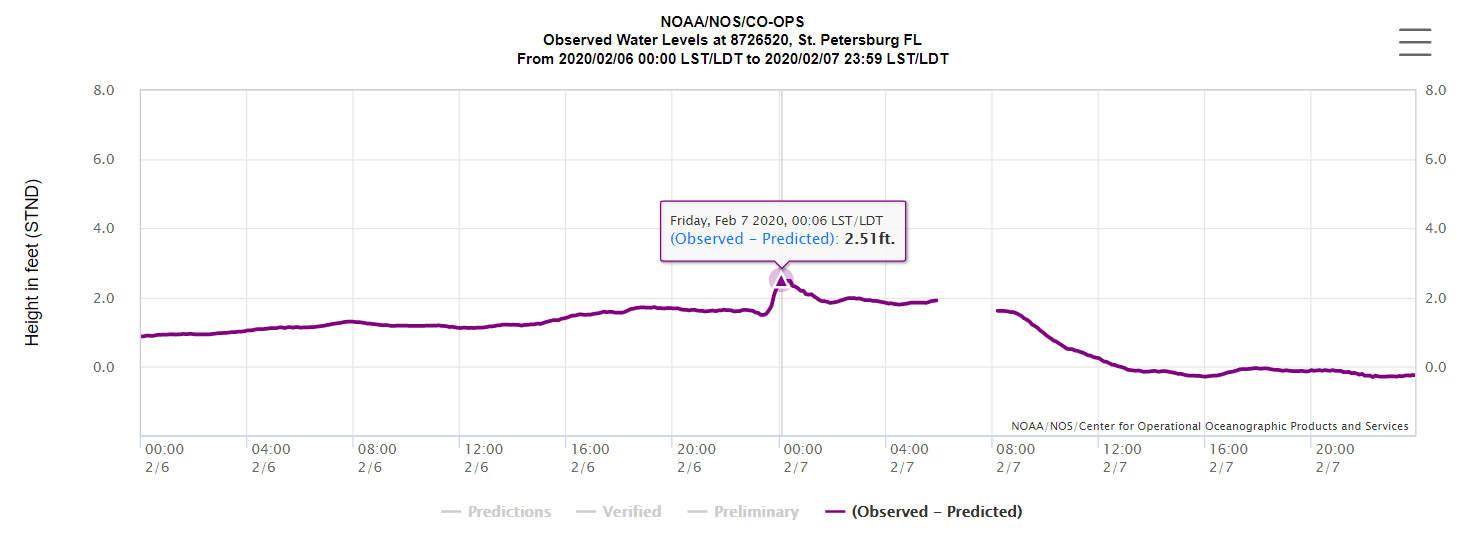 |
| St Petersburg, FL |
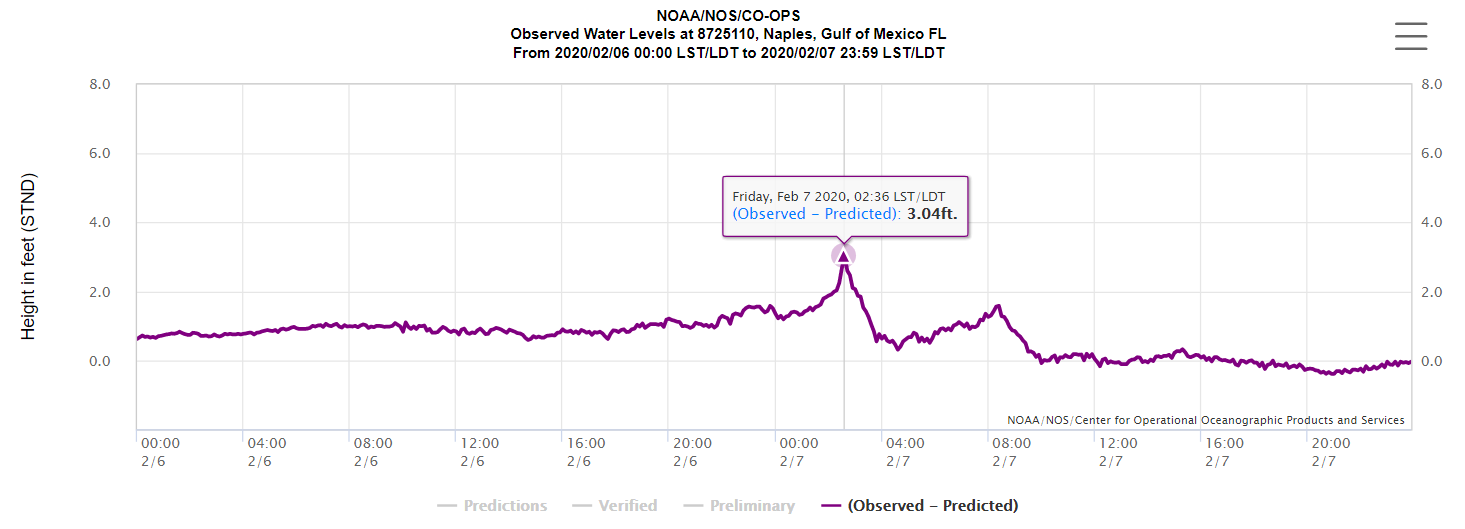 |
| Naples, FL |
Text Products
Wind/Lake Wind Advisory issued at 359 AM EST
URGENT - WEATHER MESSAGE National Weather Service Tampa Bay Ruskin FL 359 AM EST Thu Feb 6 2020 FLZ043-050-052-056-057-061-139-142-148-149-151-155-160-239-242- 248-249-251-255-260-061700- /O.NEW.KTBW.WI.Y.0001.200206T1800Z-200207T1200Z/ Sumter-Pinellas-Polk-Hardee-Highlands-DeSoto-Coastal Levy- Coastal Citrus-Coastal Hernando-Coastal Pasco- Coastal Hillsborough-Coastal Manatee-Coastal Sarasota-Inland Levy- Inland Citrus-Inland Hernando-Inland Pasco-Inland Hillsborough- Inland Manatee-Inland Sarasota- Including the cities of Wildwood, Lake Panasoffkee, Bushnell, The Villages, St. Petersburg, Clearwater, Largo, Lakeland, Winter Haven, Wauchula, Bowling Green, Zolfo Springs, Sebring, Avon Park, Placid Lakes, Arcadia, Cedar Key, Yankeetown, Crystal River, Homosassa, Hernando Beach, Bayport, Port Richey, Hudson, Tampa, Apollo Beach, Westchase, Bradenton, Anna Maria Island, Venice, Sarasota, Englewood, Chiefland, Bronson, Williston, Inverness, Brooksville, Spring Hill, Dade City, Zephyrhills, Brandon, Plant City, Sun City Center, Parrish, Lakewood Ranch, Myakka City, and North Port 359 AM EST Thu Feb 6 2020 ...WIND ADVISORY IN EFFECT FROM 1 PM THIS AFTERNOON TO 7 AM EST FRIDAY... * WHAT...Southwest winds 20 to 25 mph with gusts up to 45 mph expected. * WHERE...Portions of west central Florida. * WHEN...From 1 PM this afternoon to 7 AM EST Friday. * IMPACTS...Gusty winds could blow around unsecured objects. Tree limbs could be blown down and a few power outages may result. * ADDITIONAL DETAILS...Winds will increase during the day Thursday into Thursday Night. PRECAUTIONARY/PREPAREDNESS ACTIONS... Use extra caution when driving, especially if operating a high profile vehicle. Secure outdoor objects. && $$ FLZ162-165-262-265-061700- /O.NEW.KTBW.LW.Y.0001.200206T1800Z-200207T1200Z/ Coastal Charlotte-Coastal Lee-Inland Charlotte-Inland Lee- Including the cities of Port Charlotte, Punta Gorda, Cape Coral, Captiva, Sanibel, Babcock Ranch, Fort Myers, and Lehigh Acres 359 AM EST Thu Feb 6 2020 ...LAKE WIND ADVISORY IN EFFECT FROM 1 PM THIS AFTERNOON TO 7 AM EST FRIDAY... * WHAT...Southwest winds 15 to 25 mph with gusts up to 35 mph expected. * WHERE...Coastal Charlotte, Coastal Lee, Inland Charlotte and Inland Lee Counties. * WHEN...From 1 PM this afternoon to 7 AM EST Friday. * IMPACTS...Strong winds and rough waves on area lakes will create hazardous conditions for small craft. PRECAUTIONARY/PREPAREDNESS ACTIONS... Boaters on area lakes should use extra caution since strong winds and rough waves can overturn small craft. && $$ For more information from the National Weather Service visit https://weather.gov/tampa
Tornado Watch issued at 532 PM EST
WATCH COUNTY NOTIFICATION FOR WATCH 32 NATIONAL WEATHER SERVICE TAMPA BAY AREA - RUSKIN FL 532 PM EST THU FEB 6 2020 FLC017-075-070500- /O.NEW.KTBW.TO.A.0032.200206T2232Z-200207T0500Z/ THE NATIONAL WEATHER SERVICE HAS ISSUED TORNADO WATCH 32 IN EFFECT UNTIL MIDNIGHT EST TONIGHT FOR THE FOLLOWING AREAS IN FLORIDA THIS WATCH INCLUDES 2 COUNTIES IN NORTHERN FLORIDA LEVY IN WEST CENTRAL FLORIDA CITRUS THIS INCLUDES THE CITIES OF BEVERLY HILLS, BRONSON, CEDAR KEY, CHIEFLAND, CITRUS SPRINGS, FANNING SPRINGS, FLORAL CITY, HERNANDO, HOMOSASSA SPRINGS, INVERNESS, LECANTO, AND WILLISTON.
Severe Thunderstorm Warning issued at 833 PM EST
BULLETIN - IMMEDIATE BROADCAST REQUESTED Severe Thunderstorm Warning National Weather Service Tampa Bay Area Ruskin FL 833 PM EST Thu Feb 6 2020 The National Weather Service in Ruskin has issued a * Severe Thunderstorm Warning for... Levy County in northern Florida... * Until 930 PM EST. * At 831 PM EST, severe thunderstorms were located along a line extending from near Cross City to 59 miles west of Hudson, moving east at 35 mph. HAZARD...60 mph wind gusts. SOURCE...Radar indicated. IMPACT...Expect damage to roofs, siding, and trees. * Locations impacted include... Chiefland, Bronson, East Bronson, Fowlers Bluff, Andrews, Manattee Road, Williston Highlands, Inglis, Fanning Springs, Otter Creek, Lebanon and Manatee Springs State Park. PRECAUTIONARY/PREPAREDNESS ACTIONS... A Tornado Watch remains in effect until midnight EST for northern and west central Florida. Remain alert for a possible tornado! Tornadoes can develop quickly from severe thunderstorms. If you spot a tornado go at once into a small central room in a sturdy structure. For your protection move to an interior room on the lowest floor of a building. && LAT...LON 2929 8316 2935 8306 2959 8294 2957 8266 2954 8265 2954 8256 2948 8255 2948 8248 2903 8268 2900 8275 2899 8273 2894 8272 2897 8283 2910 8289 2911 8294 2904 8302 2906 8313 2917 8317 TIME...MOT...LOC 0131Z 262DEG 31KT 2964 8319 2861 8364 TORNADO...POSSIBLE HAIL...<.75IN WIND...60MPH $$ TBW
Tornado Watch issued at 927 PM EST
WATCH COUNTY NOTIFICATION FOR WATCHES 32/33 NATIONAL WEATHER SERVICE TAMPA BAY AREA - RUSKIN FL 927 PM EST THU FEB 6 2020 FLC015-027-049-053-055-057-071-081-101-103-105-115-119-070800- /O.NEW.KTBW.TO.A.0033.200207T0227Z-200207T0800Z/ THE NATIONAL WEATHER SERVICE HAS ISSUED TORNADO WATCH 33 IN EFFECT UNTIL 3 AM EST FRIDAY FOR THE FOLLOWING AREAS IN FLORIDA THIS WATCH INCLUDES 13 COUNTIES IN CENTRAL FLORIDA HARDEE POLK SUMTER IN SOUTH CENTRAL FLORIDA DESOTO HIGHLANDS IN SOUTHWEST FLORIDA CHARLOTTE LEE IN WEST CENTRAL FLORIDA HERNANDO HILLSBOROUGH MANATEE PASCO PINELLAS SARASOTA THIS INCLUDES THE CITIES OF ARCADIA, AVON PARK, BAYSHORE GARDENS, BONITA SPRINGS, BOWLING GREEN, BRADENTON, BRANDON, BROOKSVILLE, BUSHNELL, CAPE CORAL, CLEARWATER, DADE CITY, ENGLEWOOD, FORT MYERS, HOLIDAY, HUDSON, JASMINE ESTATES, LAKE PANASOFFKEE, LAKELAND, LAND O LAKES, LARGO, LEHIGH ACRES, NEW PORT RICHEY, NORTH FORT MYERS, NORTH PORT, PALMETTO, PLACID LAKES, PORT CHARLOTTE, PUNTA GORDA, SARASOTA, SEBRING, SOUTH VENICE, SPRING HILL, ST. PETERSBURG, TAMPA, THE VILLAGES, VENICE, WAUCHULA, WILDWOOD, WINTER HAVEN, ZEPHYRHILLS, AND ZOLFO SPRINGS. $$ GMZ830-836-850-853-856-070800- /O.NEW.KTBW.TO.A.0033.200207T0227Z-200207T0800Z/ THE NATIONAL WEATHER SERVICE HAS ISSUED TORNADO WATCH 33 IN EFFECT UNTIL 3 AM EST FRIDAY FOR THE FOLLOWING AREAS THIS WATCH INCLUDES THE FOLLOWING ADJACENT COASTAL WATERS TAMPA BAY WATERS CHARLOTTE HARBOR AND PINE ISLAND SOUND COASTAL WATERS FROM TARPON SPRINGS TO SUWANNEE RIVER FL OUT 20 NM COASTAL WATERS FROM ENGLEWOOD TO TARPON SPRINGS FL OUT 20 NM COASTAL WATERS FROM BONITA BEACH TO ENGLEWOOD FL OUT 20 NM $$ FLC017-075-070500- /O.CON.KTBW.TO.A.0032.000000T0000Z-200207T0500Z/ TORNADO WATCH 32 REMAINS VALID UNTIL MIDNIGHT EST TONIGHT FOR THE FOLLOWING AREAS IN FLORIDA THIS WATCH INCLUDES 2 COUNTIES IN NORTHERN FLORIDA LEVY IN WEST CENTRAL FLORIDA CITRUS THIS INCLUDES THE CITIES OF BEVERLY HILLS, BRONSON, CEDAR KEY, CHIEFLAND, CITRUS SPRINGS, FANNING SPRINGS, FLORAL CITY, HERNANDO, HOMOSASSA SPRINGS, INVERNESS, LECANTO, AND WILLISTON. $$
Severe Thunderstorm Warning issued at 928 PM EST
BULLETIN - IMMEDIATE BROADCAST REQUESTED Severe Thunderstorm Warning National Weather Service Tampa Bay Area Ruskin FL 928 PM EST Thu Feb 6 2020 The National Weather Service in Ruskin has issued a * Severe Thunderstorm Warning for... Western Citrus County in west central Florida... Levy County in northern Florida... * Until 1015 PM EST. * At 928 PM EST, severe thunderstorms were located along a line extending from 8 miles northwest of Archer to 37 miles west of Harbor Bluffs, moving east at 35 mph. HAZARD...60 mph wind gusts. SOURCE...Radar indicated. IMPACT...Expect damage to roofs, siding, and trees. * Locations impacted include... Williston, Bronson, Homosassa Springs, Beverly Hills, Williston Highlands, East Bronson, Crystal River Airport, Williston Municipal Airport, Black Diamond, Homosassa, Sugarmill Woods, Inglis, Otter Creek, Lecanto, Green Acres, Citronelle, Crystal Manor, Crystal Oaks, Citrus Springs and Pine Ridge. PRECAUTIONARY/PREPAREDNESS ACTIONS... A Tornado Watch remains in effect until midnight EST for northern and west central Florida. A Tornado Watch also remains in effect until 300 AM EST for west central Florida. Remain alert for a possible tornado! Tornadoes can develop quickly from severe thunderstorms. If you spot a tornado go at once into a small central room in a sturdy structure. For your protection move to an interior room on the lowest floor of a building. && LAT...LON 2954 8256 2948 8255 2948 8241 2943 8240 2922 8240 2921 8254 2904 8254 2901 8240 2869 8258 2867 8266 2866 8264 2867 8270 2867 8276 2880 8282 2892 8277 2910 8289 2911 8294 2905 8300 2906 8300 2957 8269 TIME...MOT...LOC 0228Z 265DEG 30KT 2959 8265 2804 8342 TORNADO...POSSIBLE HAIL...<.75IN WIND...60MPH $$ TBW
Severe Thunderstorm Warning issued at 1002 PM EST
BULLETIN - IMMEDIATE BROADCAST REQUESTED Severe Thunderstorm Warning National Weather Service Tampa Bay Area Ruskin FL 1002 PM EST Thu Feb 6 2020 The National Weather Service in Ruskin has issued a * Severe Thunderstorm Warning for... Citrus County in west central Florida... Northwestern Sumter County in central Florida... Central Pasco County in west central Florida... Hernando County in west central Florida... Southeastern Levy County in northern Florida... Pinellas County in west central Florida... Northwestern Hillsborough County in west central Florida... * Until 1100 PM EST. * At 1002 PM EST, severe thunderstorms were located along a line extending from near Williston to 8 miles southwest of Homosassa to 36 miles southwest of Harbor Bluffs, moving east at 30 mph. HAZARD...60 mph wind gusts. SOURCE...Radar indicated. IMPACT...Expect damage to roofs, siding, and trees. * Locations impacted include... Tampa, Spring Hill, Clearwater, Largo, Pinellas Park, Seminole, New Port Richey, Brooksville, Inverness, Wildwood, Williston, Bushnell, Downtown Saint Petersburg, Hudson, Beverly Hills, Holiday, Homosassa Springs, Saint Petersburg, Lutz and Fort Desoto Park. PRECAUTIONARY/PREPAREDNESS ACTIONS... A Tornado Watch remains in effect until midnight EST for northern and west central Florida. A Tornado Watch also remains in effect until 300 AM EST for central and west central Florida. Remain alert for a possible tornado! Tornadoes can develop quickly from severe thunderstorms. If you spot a tornado go at once into a small central room in a sturdy structure. For your protection move to an interior room on the lowest floor of a building. && LAT...LON 2922 8240 2921 8253 2904 8251 2905 8246 2896 8231 2896 8199 2762 8266 2762 8282 2772 8281 2785 8291 2812 8288 2821 8292 2828 8280 2857 8272 2871 8278 2948 8241 TIME...MOT...LOC 0302Z 269DEG 25KT 2944 8241 2870 8273 2770 8338 TORNADO...POSSIBLE HAIL...<.75IN WIND...60MPH $$ TBW
Tornado Warning issued at 1031 PM EST
BULLETIN - EAS ACTIVATION REQUESTED Tornado Warning National Weather Service Tampa Bay Area Ruskin FL 1031 PM EST Thu Feb 6 2020 The National Weather Service in Ruskin has issued a * Tornado Warning for... Central Pinellas County in west central Florida... * Until 1100 PM EST. * At 1031 PM EST, a severe thunderstorm capable of producing a tornado was located near Seminole, moving east at 35 mph. HAZARD...Tornado. SOURCE...Radar indicated rotation. IMPACT...Flying debris will be dangerous to those caught without shelter. Mobile homes will be damaged or destroyed. Damage to roofs, windows, and vehicles will occur. Tree damage is likely. * This dangerous storm will be near... Bay Pines around 1035 PM EST. Largo and Seminole around 1040 PM EST. Pinellas Park and South Highpoint around 1045 PM EST. Feather Sound and West And East Lealman around 1050 PM EST. Gandy around 1055 PM EST. Other locations impacted by this tornadic thunderstorm include Redington Beach, Indian Shores, Walsingham Park, Weedon Island State Preserve, Sawgrass Lake Park, North Redington Beach, Redington Shores, Kenneth City and Madeira Beach. PRECAUTIONARY/PREPAREDNESS ACTIONS... TAKE COVER NOW! Move to an interior room on the lowest floor of a sturdy building. Avoid windows. If you are outdoors, in a mobile home, or in a vehicle, move to the closest substantial shelter and protect yourself from flying debris. && LAT...LON 2780 8287 2787 8289 2792 8264 2784 8258 TIME...MOT...LOC 0331Z 260DEG 32KT 2784 8285 TORNADO...RADAR INDICATED HAIL...0.00IN $$ TBW
Severe Thunderstorm Warning issued at 1050 PM EST
BULLETIN - IMMEDIATE BROADCAST REQUESTED Severe Thunderstorm Warning National Weather Service Tampa Bay Area Ruskin FL 1050 PM EST Thu Feb 6 2020 The National Weather Service in Ruskin has issued a * Severe Thunderstorm Warning for... Sumter County in central Florida... Pasco County in west central Florida... Eastern Hernando County in west central Florida... Northwestern Manatee County in west central Florida... Central Pinellas County in west central Florida... Hillsborough County in west central Florida... Northwestern Polk County in central Florida... Northwestern Sarasota County in west central Florida... * Until 1145 PM EST. * At 1049 PM EST, severe thunderstorms were located along a line extending from 9 miles northeast of Inverness to near Land O Lakes to 25 miles southwest of Anna Maria, moving east at 35 mph. HAZARD...60 mph wind gusts. SOURCE...Radar indicated. IMPACT...Expect damage to roofs, siding, and trees. * Locations impacted include... Tampa, Clearwater, Lakeland, Largo, Sarasota, Bradenton, Pinellas Park, Plant City, Temple Terrace, Seminole, Auburndale, Zephyrhills, Palmetto, Brooksville, Wildwood, Dade City, Bushnell, Fort Desoto Park, Fish Hawk and Saint Petersburg. PRECAUTIONARY/PREPAREDNESS ACTIONS... A Tornado Watch remains in effect until 300 AM EST for central and west central Florida. Remain alert for a possible tornado! Tornadoes can develop quickly from severe thunderstorms. If you spot a tornado go at once into a small central room in a sturdy structure. For your protection move to an interior room on the lowest floor of a building. && LAT...LON 2827 8255 2867 8234 2867 8227 2872 8225 2876 8218 2878 8219 2879 8217 2886 8223 2896 8218 2896 8196 2835 8196 2835 8166 2823 8170 2725 8245 2725 8263 2757 8283 2772 8281 2777 8285 TIME...MOT...LOC 0349Z 266DEG 31KT 2894 8223 2819 8253 2736 8311 TORNADO...POSSIBLE HAIL...<.75IN WIND...60MPH $$ TBW
Tornado Warning issued at 1051 PM EST
BULLETIN - EAS ACTIVATION REQUESTED Tornado Warning National Weather Service Tampa Bay Area Ruskin FL 1051 PM EST Thu Feb 6 2020 The National Weather Service in Ruskin has issued a * Tornado Warning for... East central Pinellas County in west central Florida... Central Hillsborough County in west central Florida... * Until 1115 PM EST. * At 1050 PM EST, a severe thunderstorm capable of producing a tornado was located over Gandy, or near Pinellas Park, moving east at 35 mph. HAZARD...Tornado. SOURCE...Radar indicated rotation. IMPACT...Flying debris will be dangerous to those caught without shelter. Mobile homes will be damaged or destroyed. Damage to roofs, windows, and vehicles will occur. Tree damage is likely. * This dangerous storm will be near... Palm River-Clair Mel around 1110 PM EST. Other locations impacted by this tornadic thunderstorm include South Tampa, Soho, Channelside, University Of Tampa, Weedon Island State Preserve, Peter O Knight Airport, Davis Islands and Sawgrass Lake Park. PRECAUTIONARY/PREPAREDNESS ACTIONS... TAKE COVER NOW! Move to an interior room on the lowest floor of a sturdy building. Avoid windows. If you are outdoors, in a mobile home, or in a vehicle, move to the closest substantial shelter and protect yourself from flying debris. && LAT...LON 2783 8267 2791 8267 2796 8241 2787 8239 TIME...MOT...LOC 0350Z 255DEG 44KT 2789 8261 TORNADO...RADAR INDICATED HAIL...0.00IN $$ TBW
Tornado Warning issued at 1113 PM EST
BULLETIN - EAS ACTIVATION REQUESTED Tornado Warning National Weather Service Tampa Bay Area Ruskin FL 1113 PM EST Thu Feb 6 2020 The National Weather Service in Ruskin has issued a * Tornado Warning for... Northeastern Manatee County in west central Florida... Southeastern Hillsborough County in west central Florida... * Until 1145 PM EST. * At 1113 PM EST, a severe thunderstorm capable of producing a tornado was located near Ruskin, or 10 miles southeast of Downtown Saint Petersburg, moving east at 50 mph. HAZARD...Tornado. SOURCE...Radar indicated rotation. IMPACT...Flying debris will be dangerous to those caught without shelter. Mobile homes will be damaged or destroyed. Damage to roofs, windows, and vehicles will occur. Tree damage is likely. * This dangerous storm will be near... Greater Sun Center around 1125 PM EST. Other locations impacted by this tornadic thunderstorm include Little Manatee River State Park, Alafia River State Park, Wimauma, Sun City Center and Fort Lonesome. PRECAUTIONARY/PREPAREDNESS ACTIONS... TAKE COVER NOW! Move to an interior room on the lowest floor of a sturdy building. Avoid windows. If you are outdoors, in a mobile home, or in a vehicle, move to the closest substantial shelter and protect yourself from flying debris. && LAT...LON 2763 8257 2770 8257 2779 8209 2760 8207 TIME...MOT...LOC 0413Z 266DEG 44KT 2767 8251 TORNADO...RADAR INDICATED HAIL...0.00IN $$ TBW
Tornado Warning issued at 1117 PM EST
BULLETIN - EAS ACTIVATION REQUESTED Tornado Warning National Weather Service Tampa Bay Area Ruskin FL 1117 PM EST Thu Feb 6 2020 The National Weather Service in Ruskin has issued a * Tornado Warning for... Central Manatee County in west central Florida... Northwestern Sarasota County in west central Florida... * Until 1145 PM EST. * At 1116 PM EST, a severe thunderstorm capable of producing a tornado was located near South Bradenton, or near Bradenton, moving east at 30 mph. HAZARD...Tornado. SOURCE...Radar indicated rotation. IMPACT...Flying debris will be dangerous to those caught without shelter. Mobile homes will be damaged or destroyed. Damage to roofs, windows, and vehicles will occur. Tree damage is likely. * This dangerous storm will be near... West Bradenton around 1120 PM EST. Palmetto and South Bradenton around 1125 PM EST. Bradenton, West Samoset, Sarasota Bradenton Airport and Memphis around 1130 PM EST. Ellenton around 1135 PM EST. Lakewood Ranch around 1140 PM EST. Other locations impacted by this tornadic thunderstorm include Bayshore Gardens, Lake Manatee State Park, Samoset and Oneco. PRECAUTIONARY/PREPAREDNESS ACTIONS... TAKE COVER NOW! Move to an interior room on the lowest floor of a sturdy building. Avoid windows. If you are outdoors, in a mobile home, or in a vehicle, move to the closest substantial shelter and protect yourself from flying debris. && LAT...LON 2739 8262 2751 8263 2760 8223 2739 8216 TIME...MOT...LOC 0416Z 267DEG 27KT 2744 8265 TORNADO...RADAR INDICATED HAIL...0.00IN $$ TBW
Severe Thunderstorm Warning issued at 1144 PM EST
BULLETIN - IMMEDIATE BROADCAST REQUESTED Severe Thunderstorm Warning National Weather Service Tampa Bay Area Ruskin FL 1144 PM EST Thu Feb 6 2020 The National Weather Service in Ruskin has issued a * Severe Thunderstorm Warning for... Northwestern Highlands County in south central Florida... Southeastern Sumter County in central Florida... Hardee County in central Florida... Manatee County in west central Florida... Polk County in central Florida... Southeastern Hillsborough County in west central Florida... Northern DeSoto County in south central Florida... Northern Sarasota County in west central Florida... * Until 1245 AM EST. * At 1144 PM EST, severe thunderstorms were located along a line extending from 9 miles west of Four Corners to 18 miles southwest of Gulf Gate Estates, moving east at 50 mph. HAZARD...60 mph wind gusts. SOURCE...Radar indicated. IMPACT...Expect damage to roofs, siding, and trees. * Locations impacted include... Lakeland, Sarasota, Plant City, Winter Haven, Haines City, Bartow, Lake Wales, Auburndale, Sebring, Avon Park, Arcadia, Wauchula, Fish Hawk, South Gate Ridge Lake Sarasota, North Sarasota, Southgate, Gulf Gate Estates, The Meadows and Medulla. PRECAUTIONARY/PREPAREDNESS ACTIONS... A Tornado Watch remains in effect until 300 AM EST for south central, central and west central Florida. For your protection move to an interior room on the lowest floor of a building. && LAT...LON 2718 8171 2717 8257 2732 8256 2822 8198 2835 8196 2835 8186 2836 8185 2835 8166 2826 8166 2826 8156 2814 8152 2814 8146 2809 8145 2808 8135 2801 8138 2806 8145 2800 8142 2792 8131 2786 8131 2784 8125 TIME...MOT...LOC 0444Z 260DEG 44KT 2833 8180 2702 8265 HAIL...<.75IN WIND...60MPH $$ TBW
Storm Reports
Map:
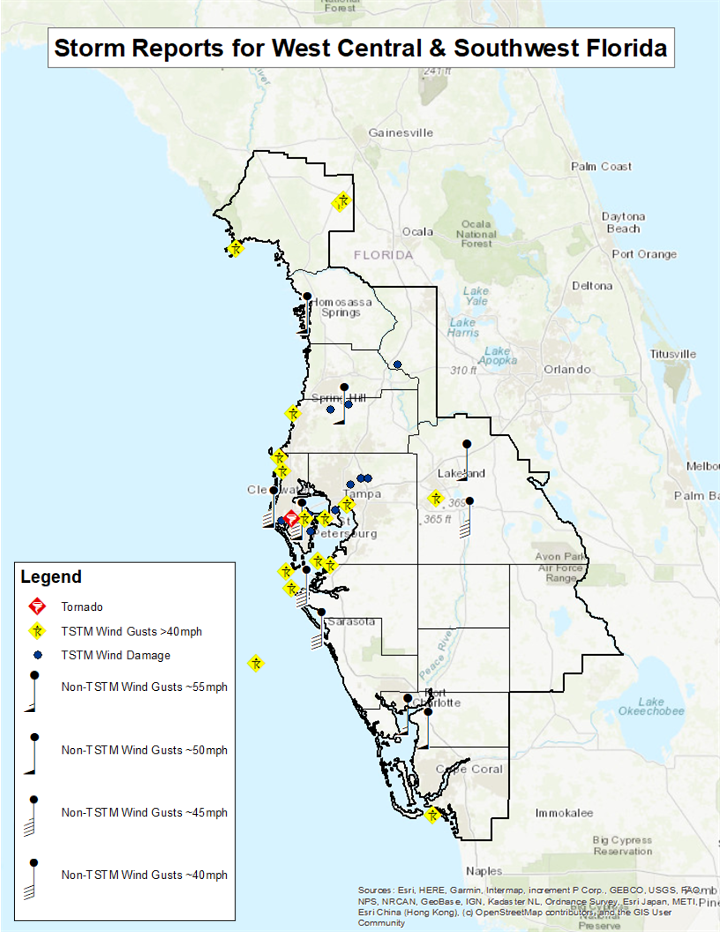 |
Text Listing:
PRELIMINARY LOCAL STORM REPORT
NATIONAL WEATHER SERVICE TAMPA BAY RUSKIN FL
..TIME... ...EVENT... ...CITY LOCATION... ...LAT.LON...
..DATE... ....MAG.... ..COUNTY LOCATION..ST.. ...SOURCE....
..REMARKS..
1150 AM Non-Tstm Wnd Gst 2 NNE Masaryktown 28.47N 82.45W
02/06/2020 M43 MPH Hernando FL ASOS
ASOS station KBKV Brooksville.
1157 AM Non-Tstm Wnd Gst 1 S Whitfield 27.40N 82.57W
02/06/2020 M41 MPH Manatee FL ASOS
ASOS station KSRQ Sarasota Bradent.
1158 AM Non-Tstm Wnd Gst 2 NNE Masaryktown 28.47N 82.45W
02/06/2020 M46 MPH Hernando FL ASOS
ASOS station KBKV Brooksville.
0150 PM Non-Tstm Wnd Gst 2 SE Solana 26.92N 82.00W
02/06/2020 M48 MPH Charlotte FL ASOS
ASOS station KPGD Punta Gorda.
0152 PM Non-Tstm Wnd Gst 2 NW Feather Sound 27.92N 82.68W
02/06/2020 M44 MPH GMZ830 FL ASOS
ASOS station KPIE St Petersburg.
0215 PM Non-Tstm Wnd Dmg Duette 27.59N 82.12W
02/06/2020 Manatee FL Public
Power poles knocked down along State Road 62
between Duette and State Road 37.
0227 PM Non-Tstm Wnd Gst 1 S Whitfield 27.40N 82.57W
02/06/2020 M43 MPH Manatee FL ASOS
ASOS station KSRQ Sarasota Bradent.
0231 PM Non-Tstm Wnd Gst 2 NW Feather Sound 27.92N 82.68W
02/06/2020 M46 MPH GMZ830 FL ASOS
ASOS station KPIE St Petersburg.
0239 PM Non-Tstm Wnd Gst 2 NNE Masaryktown 28.47N 82.45W
02/06/2020 M47 MPH Hernando FL ASOS
ASOS station KBKV Brooksville.
0244 PM Non-Tstm Wnd Gst 2 NW Feather Sound 27.92N 82.68W
02/06/2020 M49 MPH GMZ830 FL ASOS
ASOS station KPIE St Petersburg.
0255 PM Non-Tstm Wnd Gst 3 SW Wahneta 27.93N 81.77W
02/06/2020 M45 MPH Polk FL AWOS
AWOS station KBOW Bartow Municipal.
0305 PM Non-Tstm Wnd Gst 2 NW Port Charlotte 26.99N 82.11W
02/06/2020 M55 MPH Charlotte FL Mesonet
Mesonet station DW9045 Port Charlotte.
0307 PM Non-Tstm Wnd Gst 3 ENE Polk City 28.20N 81.79W
02/06/2020 M56 MPH Polk FL Mesonet
Mesonet station AS291 Polk City.
0328 PM Non-Tstm Wnd Dmg 1 S Winter Haven 28.01N 81.72W
02/06/2020 Polk FL Public
Report from public of 1-inch tree limbs
broken along with shingles blown off a roof.
0402 PM Non-Tstm Wnd Gst 7 NW Palmetto 27.60N 82.65W
02/06/2020 M46 MPH GMZ830 FL Mesonet
Mesonet station XSKY Skyway Fishing Pier.
0440 PM Non-Tstm Wnd Gst 2 NNE Masaryktown 28.47N 82.45W
02/06/2020 M51 MPH Hernando FL ASOS
ASOS station KBKV Brooksville.
0445 PM Non-Tstm Wnd Gst 2 NW Feather Sound 27.92N 82.68W
02/06/2020 M51 MPH GMZ830 FL ASOS
ASOS station KPIE St Petersburg.
0448 PM Non-Tstm Wnd Gst 3 NNW Belleair 27.98N 82.83W
02/06/2020 M47 MPH GMZ853 FL Buoy
Buoy station CWBF1 Clearwater Beach Pier 60.
0500 PM Non-Tstm Wnd Gst 3 NNW Belleair 27.98N 82.83W
02/06/2020 M49 MPH GMZ853 FL Buoy
Buoy station CWBF1 Clearwater Beach Pier 60.
0620 PM Non-Tstm Wnd Gst 3 W Crystal River 28.90N 82.65W
02/06/2020 M48 MPH Citrus FL Mesonet
Mesonet station 0212W 2.9 W Crystal River
(WEATHERSTEM).
0700 PM Non-Tstm Wnd Dmg 3 SSE Inverness 28.80N 82.32W
02/06/2020 Citrus FL Emergency Mngr
Tree fell on the back of a house and porch
on Lowden street in Inverness.
0848 PM Tstm Wnd Gst 1 SSE Cedar Key 29.14N 83.03W
02/06/2020 M43 MPH GMZ850 FL Buoy
Buoy station CKYF1 Cedar Key, FL.
0906 PM Tstm Wnd Gst 1 SSE Cedar Key 29.14N 83.03W
02/06/2020 M50 MPH GMZ850 FL Buoy
Buoy station CKYF1 Cedar Key, FL.
0955 PM Tstm Wnd Gst 2 SSW Williston 29.35N 82.47W
02/06/2020 M55 MPH Levy FL AWOS
AWOS station KX60 Williston.
1000 PM Tstm Wnd Gst Williston 29.37N 82.45W
02/06/2020 M61 MPH Levy FL Mesonet
Mesonet station 0566W Williston
(WEATHERSTEM).
1012 PM Tstm Wnd Gst 3 W Tarpon Springs 28.15N 82.80W
02/06/2020 M41 MPH GMZ853 FL Mesonet
Mesonet station FHPF1 2 W Tarpon Springs.
1014 PM Tstm Wnd Gst 1 W Hudson 28.36N 82.72W
02/06/2020 E51 MPH Pasco FL Public
1019 PM Tstm Wnd Gst 1 W Palm Harbor 28.09N 82.78W
02/06/2020 E51 MPH Pinellas FL Public
1040 PM Tstm Wnd Dmg Seminole 27.85N 82.79W
02/06/2020 Pinellas FL Emergency Mngr
*** 1 INJ ***
A tree fell onto a home in Seminole. Seven
people were reported trapped inside the
structure. One person reported injured.
1042 PM Tornado 1 W Pinellas Park 27.86N 82.73W
02/06/2020 Pinellas FL Fire Dept/Rescue
Possible Tornado. Multiple units damaged at
a different mobile home park in Pinellas
Park than previously reported. Downed power
lines.
1048 PM Tstm Wnd Gst 3 W Palm River-Clair Me 27.93N 82.43W
02/06/2020 M40 MPH GMZ830 FL Mesonet
Mesonet station TPAF1 Tpa Cruise Terminal 2.
1053 PM Tstm Wnd Gst 6 NNW Anna Maria Island 27.61N 82.76W
02/06/2020 M66 MPH GMZ853 FL Mesonet
Mesonet station XEGM Egmont Channel.
1054 PM Tstm Wnd Gst 3 W Palm River-Clair Me 27.93N 82.43W
02/06/2020 M59 MPH GMZ830 FL Mesonet
Mesonet station TSHF1 East Bay Causeway, FL.
1100 PM Tstm Wnd Gst 3 W Macdill Air Force 27.86N 82.55W
02/06/2020 M43 MPH GMZ830 FL Mesonet
Mesonet station OPTF1 Old Port Tampa, FL.
1100 PM Tstm Wnd Gst 23 SW Longboat Key 27.17N 82.92W
02/06/2020 M51 MPH GMZ873 FL Mesonet
Mesonet station 42013 22 SW Longboat Key.
1100 PM Tstm Wnd Dmg 3 N Macdill Air Force 27.90N 82.50W
02/06/2020 Hillsborough FL Public
4 trees down around home near Britton Plaza
in South Tampa.
1104 PM Tstm Wnd Gst Anna Maria Island 27.53N 82.73W
02/06/2020 E62 MPH Manatee FL Public
1112 PM Tstm Wnd Gst 8 SE Saint Petersburg 27.66N 82.59W
02/06/2020 M56 MPH GMZ830 FL Mesonet
Mesonet station MTBF1 8 SE Saint Petersburg.
1114 PM Tstm Wnd Gst 7 WNW Parrish 27.64N 82.52W
02/06/2020 E47 MPH Manatee FL Public
1117 PM Tstm Wnd Gst 3 E Pinellas Park 27.86N 82.66W
02/06/2020 E60 MPH Pinellas FL Emergency Mngr
Corrects previous tstm wnd gst report from 3
E Pinellas Park. Crane fell over onto the
roadway on I-275 at exit 29 in St.
Petersburg.
1120 PM Tstm Wnd Dmg 4 NE Saint Petersburg 27.80N 82.63W
02/06/2020 Pinellas FL Public
Report from mPING: 1-inch tree limbs broken;
Shingles blown off.
1128 PM Tstm Wnd Dmg 2 SE Feather Sound 27.88N 82.64W
02/06/2020 Pinellas FL Public
Report from mPING: 3-inch tree limbs broken;
Power poles broken.
1142 PM Tstm Wnd Dmg 1 E Temple Terrace 28.05N 82.36W
02/06/2020 Hillsborough FL Public
3-inch tree limbs broken; Power poles broken
also trees are down on N 52 st in Temple
Terrace.
1150 PM Tstm Wnd Gst Lakeland Highlands 27.96N 81.95W
02/06/2020 M54 MPH Polk FL Mesonet
Mesonet station AR692 Lakeland.
1204 AM Tstm Wnd Dmg 2 SW Thonotosassa 28.05N 82.32W
02/07/2020 Hillsborough FL Public
Report from mPING: 1-inch tree limbs broken;
Shingles blown off.
0200 AM Tstm Wnd Gst 4 SE Punta Rassa 26.44N 81.97W
02/07/2020 M46 MPH GMZ856 FL Mesonet
SCCF RECON SITE OFF FORT MYERS BEACH.
Public Information Statement National Weather Service Tampa Bay Ruskin FL 825 AM EST Fri Feb 7 2020 ...HIGHEST WIND REPORTS... A RECAP OF THE HIGHEST WIND REPORTS AVAILABLE DURING THE LAST 24 HOURS. SITES ARE LISTED BY COUNTY FOR ANY WIND SPEEDS OF 40 MPH OR GREATER. PLEASE NOTE, THIS DATA IS CONSIDERED PRELIMINARY AND HAS NOT UNDERGONE AN OFFICIAL QC. ALSO, BE SURE TO CHECK THE TIMES AS SOME SITES REPORTED THESE WINDS PRIOR TO THE ARRIVAL OF THE MAIN LINE OF STORMS. LOCATION SPEED TIME/DATE PROVIDER ...WEST CENTRAL & SOUTHWEST FLORIDA... ...CITRUS COUNTY... 2.9 W CRYSTAL RIVER 48 MPH 0620 PM 02/06 MESOWEST MARINE SCIENCE STATION 46 MPH 1010 PM 02/06 CWOP ...CHARLOTTE COUNTY... PORT CHARLOTTE (DW9045) 44 MPH 1125 PM 02/06 CWOP ...DESOTO COUNTY... ARCADIA 41 MPH 1145 PM 02/06 FAWN ...HILLSBOROUGH COUNTY.... TAMPA (DW3252) 49 MPH 1104 PM 02/06 CWOP UNIV SOUTH FL 44 MPH 1100 PM 02/06 WEATHERSTEM TAMPA INTL APT (KTPA) 41 MPH 1058 PM 02/06 ASOS PLANT CITY APT (KPCM) 41 MPH 1115 PM 02/06 AWOS TAMPA EXECUTIVE APT (KVDF) 40 MPH 1055 PM 02/06 AWOS MACDILL AFB 40 MPH 1055 PM 02/06 AWOS ...LEE COUNTY... FORT MYERS (EW3705) 44 MPH 0148 AM 02/07 CWOP SOUTHWEST FL INTL (KRSW) 41 MPH 1253 AM 02/07 ASOS ...LEVY COUNTY... WILLISTON (WEATHERSTEM) 61 MPH 1000 PM 02/06 MESOWEST WILLISTON APT (KX60) 55 MPH 0955 PM 02/06 AWOS BRONSON (BRZF1) 44 MPH 0940 PM 02/06 FAWN CEDAR KEY FIRE RESCUE 44 MPH 0910 PM 02/06 WEATHERSTEM BRONSON MIDDLE SCHOOL 43 MPH 0940 PM 02/06 WEATHERSTEM ...MANATEE COUNTY.... ANNA MARIA ISLAND 62 MPH 1104 PM 02/06 CWOP SARASOTA-BRADEN INTL (KSRQ) 43 MPH 1127 PM 02/06 ASOS PALMETTO (W4HIX-2) 42 MPH 0345 PM 02/06 CWOP ...PASCO COUNTY... HUDSON (1 W) 51 MPH 1014 PM 02/06 CWOP ZEPHYRHILLS MUNI APT (KZPH) 40 MPH 0215 PM 02/06 AWOS ...PINELLAS COUNTY... 3 E PINELLAS PARK 60 MPH 1017 PM 02/06 EMERGENCY MNGR BELLEAIR (EW6508) 45 MPH 1045 PM 02/06 CWOP CLEARWATER BEACH 43 MPH 1044 PM 02/06 CWOP ...POLK COUNTY... LAKELAND (W4HM) 55 MPH 1155 PM 02/06 CWOP LAKELAND 54 MPH 1150 PM 02/06 CWOP WINTER HAVEN APT (KGIF) 46 MPH 1207 AM 02/06 ASOS LAKE WALES MUNICIPAL APT 44 MPH 1235 AM 02/07 AWOS DUNDEE (WC4PEM) 44 MPH 1007 PM 02/06 CWOP POLK CITY (WC4PEM) 43 MPH 1257 PM 02/07 CWOP ...SARASOTA COUNTY... RINGLING MUSEUM OF ART 45 MPH 1130 PM 02/06 WEATHERSTEM THE GLENRIDGE ON PALMER RAN 43 MPH 1130 PM 02/06 WEATHERSTEM ...SUMTER COUNTY... THE VILLAGES (DW5322) 48 MPH 1100 PM 02/06 CWOP WILDWOOD (FW0974) 44 MPH 1100 PM 02/06 CWOP CENTER HIGH SCHOOL (FW2402) 42 MPH 1110 PM 02/06 CWOP ...MARITIME STATIONS... EGMONT CHANNEL 66 MPH 1053 PM 02/06 WXFLOW EAST BAY CAUSEWAY, FL 59 MPH 1054 PM 02/06 NOS-PORTS 8 SE SAINT PETERSBURG 56 MPH 1112 PM 02/06 NDBC 22 SW LONGBOAT KEY 51 MPH 1100 PM 02/06 NDBC CEDAR KEY, FL 50 MPH 0906 PM 02/06 NOS-NWLON 4 SE PUNTA RASSA 46 MPH 0200 AM 02/07 SCCF RECON OLD PORT TAMPA, FL 43 MPH 1100 PM 02/06 NOS-PORTS CEDAR KEY, FL 43 MPH 0848 PM 02/06 NOS-NWLON 2 W TARPON SPRINGS 41 MPH 1012 PM 02/06 NDBC MIDDLE TAMPA BAY 41 MPH 0312 PM 02/06 NOS TPA CRUISE TERMINAL 2 40 MPH 1048 PM 02/06 NOS-PORTS OBSERVATIONS ARE COLLECTED FROM A VARIETY OF SOURCES WITH VARYING EQUIPMENT AND EXPOSURES. WE THANK ALL VOLUNTEER WEATHER OBSERVERS FOR THEIR DEDICATION. NOT ALL DATA LISTED ARE CONSIDERED OFFICIAL.